Before I rejoined my trip up the Florida A1A scenic highway, I visited the Kennedy Space Center in Cape Canaveral for a day. This vast complex has been operating as a launch center since 1949. It was renamed for John F. Kennedy in 1963, and the visitor complex opened in 1995. It’s the visitor complex that we’ll be talking about today – the touristy part, not the rocket-launching/NASA operations part.
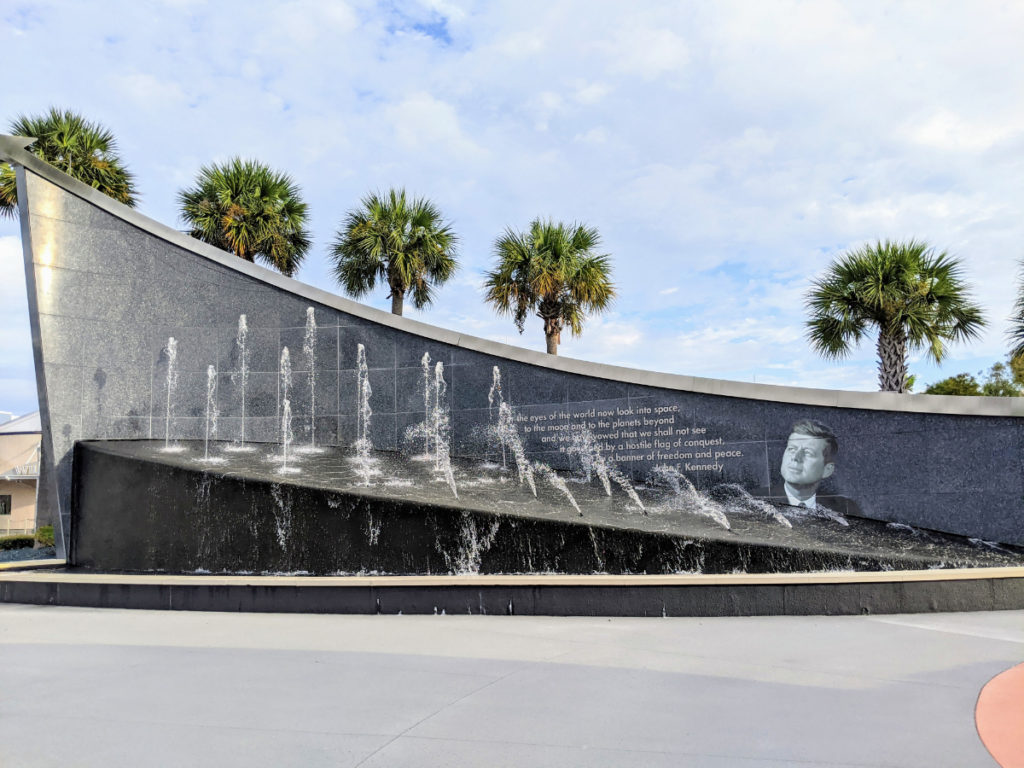
Watching a rocket launch
But wait! You may be able to watch an actual rocket launch if you time your visit right. I happened to check the schedule and found that a non-manned rocket was due to launch the morning of my visit. This particular launch was in the morning hours before the rest of the park opened. Other launches may happen in the evening where they might schedule a “Movie and a launch” event, or it may happen in the middle of the night. For instance, the next launch on February 7 will be at 4:30 am.
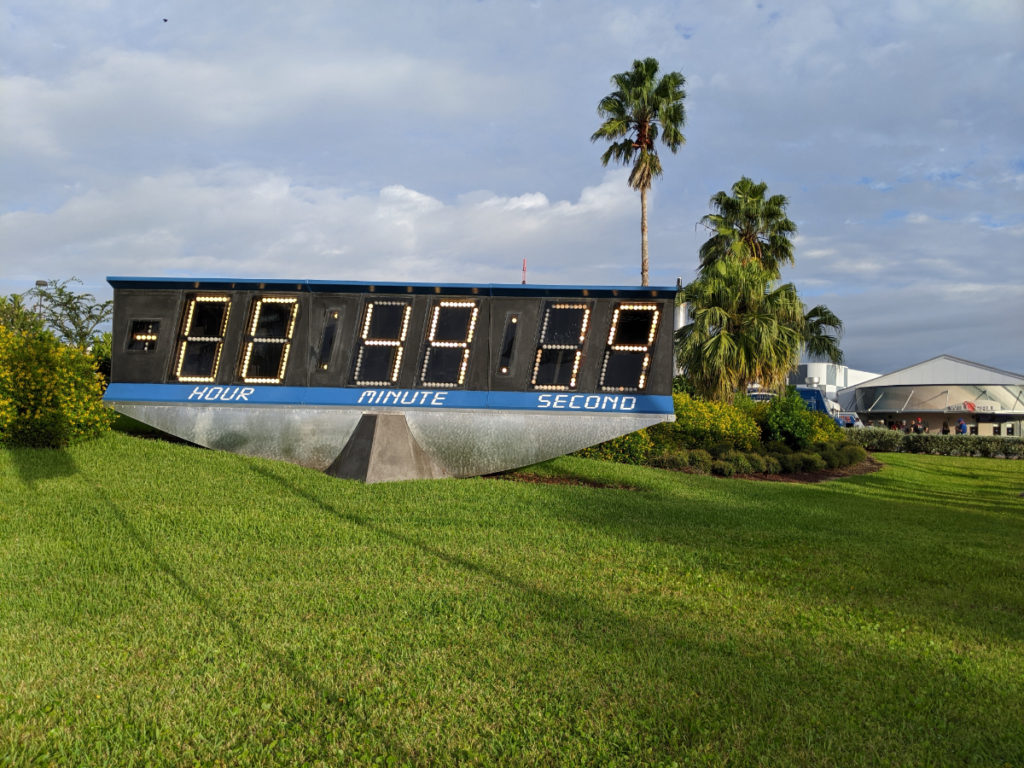
The cost to watch a launch from the Space Center is included with your daily admission ticket. For some launches, you can pay extra to view it from the Apollo/Saturn V Center, which is potentially closer.
I left early from Kissimmee to make it in time to see a launch before the rest of the park opened. The path to go back to the launch site is clearly marked (and restrooms are open – very important info for some of us!) The viewing area is a grassy lawn with bleachers and a large screen and countdown clock to one side. The rocket pad itself is several miles away.
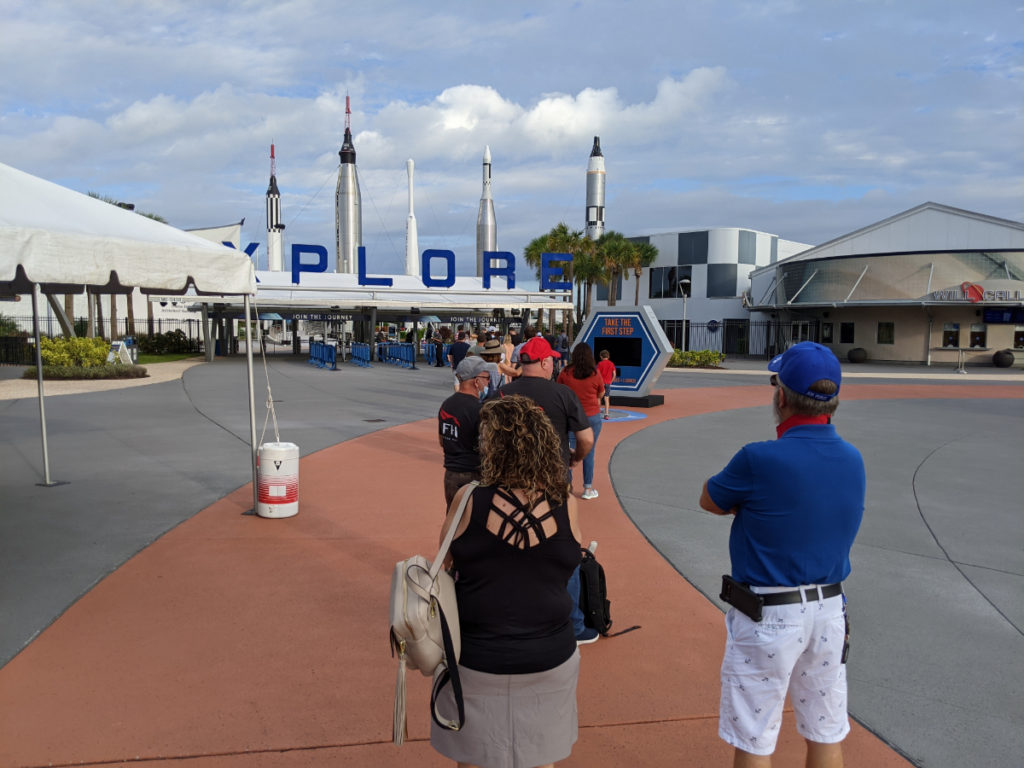
The entry line to get to the launch 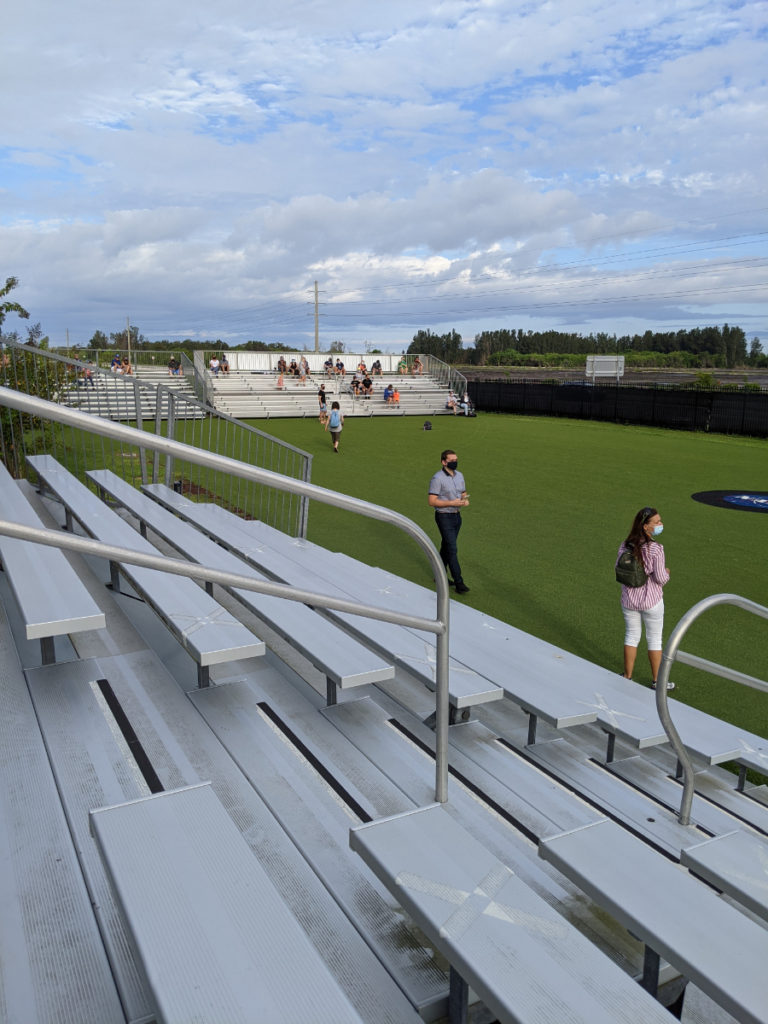
The launch viewing area 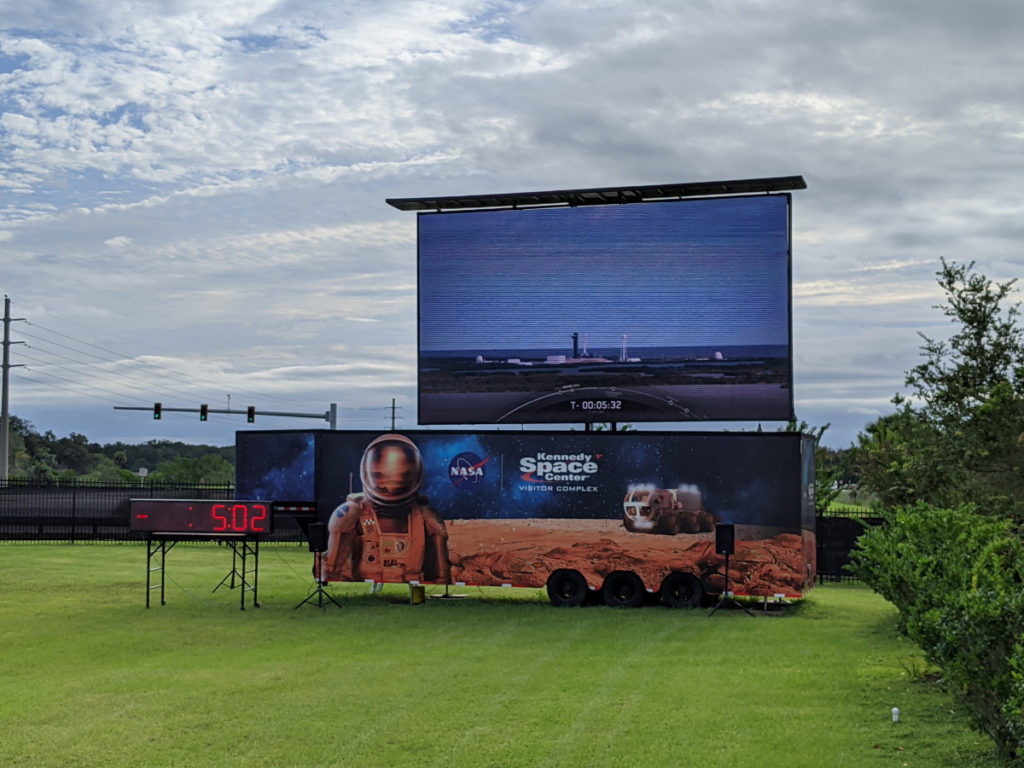
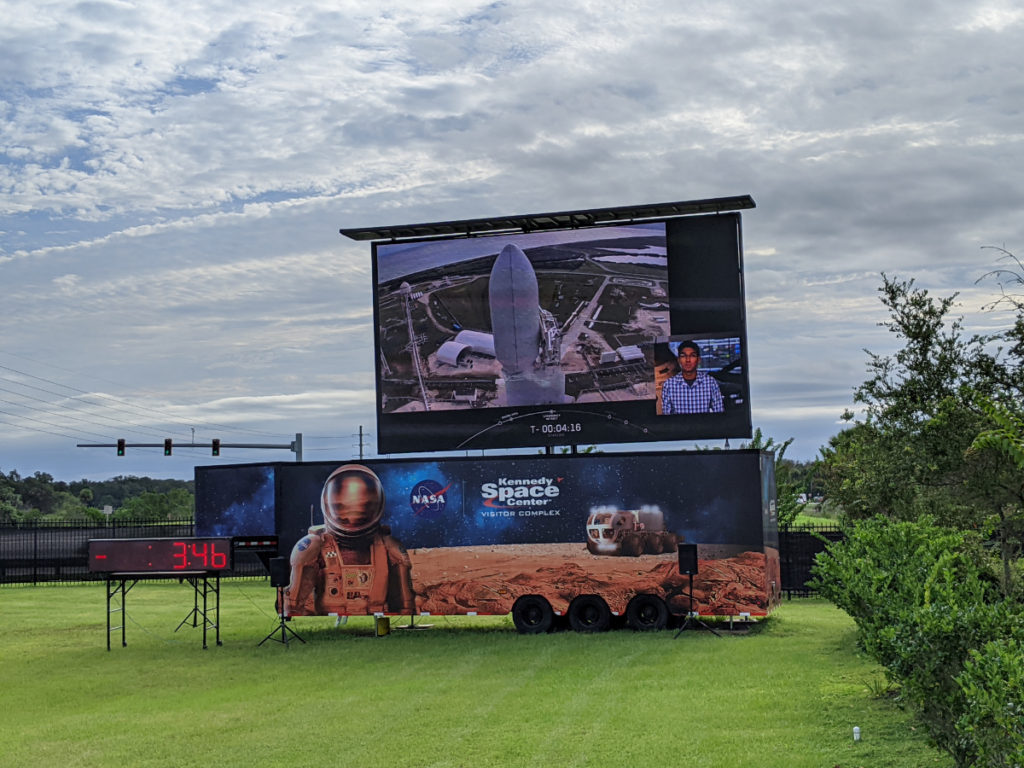
On my visit, the launch aborted with 18 seconds to go. Sadly, I didn’t get to see a rocket go up and feel the rumble in the earth. SO, just be aware that if you go to see a launch, there is a chance you won’t see one!
EDIT: December 2 launch
The type of ticket I bought for my first visit to the Kennedy Space Center allowed me to return anytime in the next calendar year, so I made sure my second visit in December lined up with another launch. This time, the launch was scheduled at 6:12 pm, so I visited the Apollo/Saturn V center that I missed the first time and watched the launch after hours. BUT, the launch was scheduled originally for the night before my visit and was bumped a day, so keep in mind that changes can happen last minute.
The cost to watch the launch from the main visitor center is included in your daily ticket and happens on a lawn near the Atlantis building. For $20 extra, you can take the bus to the Apollo/Saturn V building for a closer view. If you’re in the area but aren’t paying to visit the center on the day of a launch, there are several places nearby with a good view. I scoped out Space View Park in downtown Titusville when I thought it would launch the night before my visit. (And where I found out it had been postponed!)
Getting to watch a launch in person was really great! There’s an MC who offers pertinent information (and dad jokes, in this case – it’s very family-friendly.) A screen displays SpaceX commentary and the view from the launch pad, plus there’s a large countdown clock. When the time comes, you see the rocket go up in the distance, then a few minutes later, the wave of sound finally hits you! It’s really awe-inspiring. Check out my video below and wait for the beginnings of the roar.
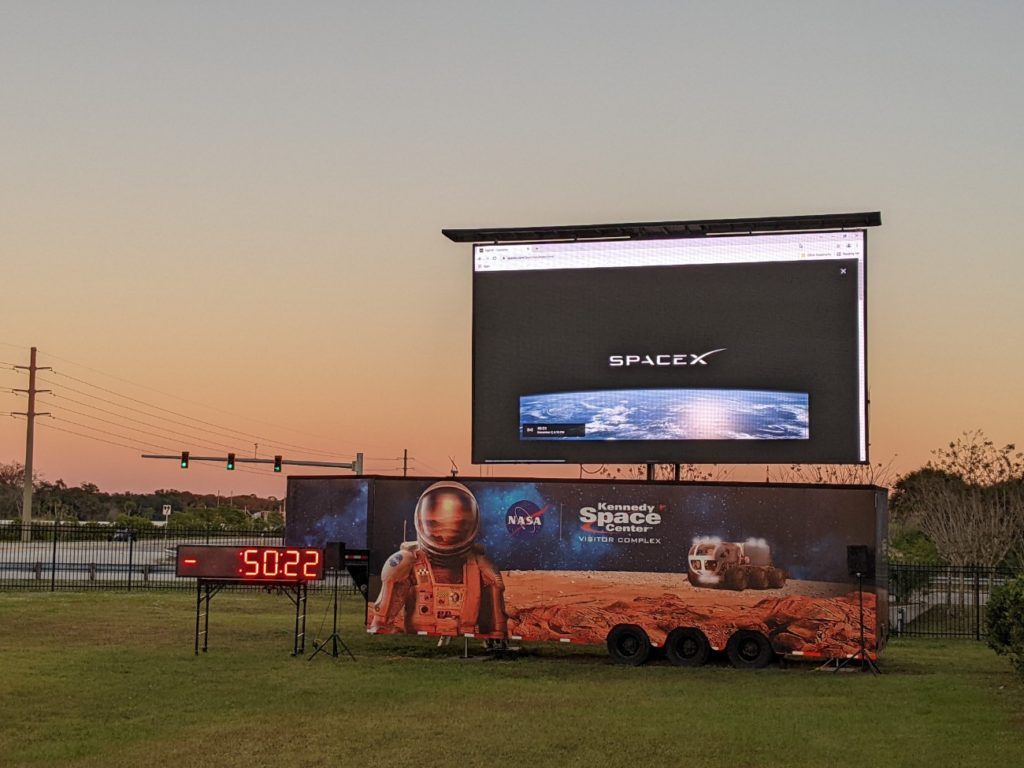
50 minutes out 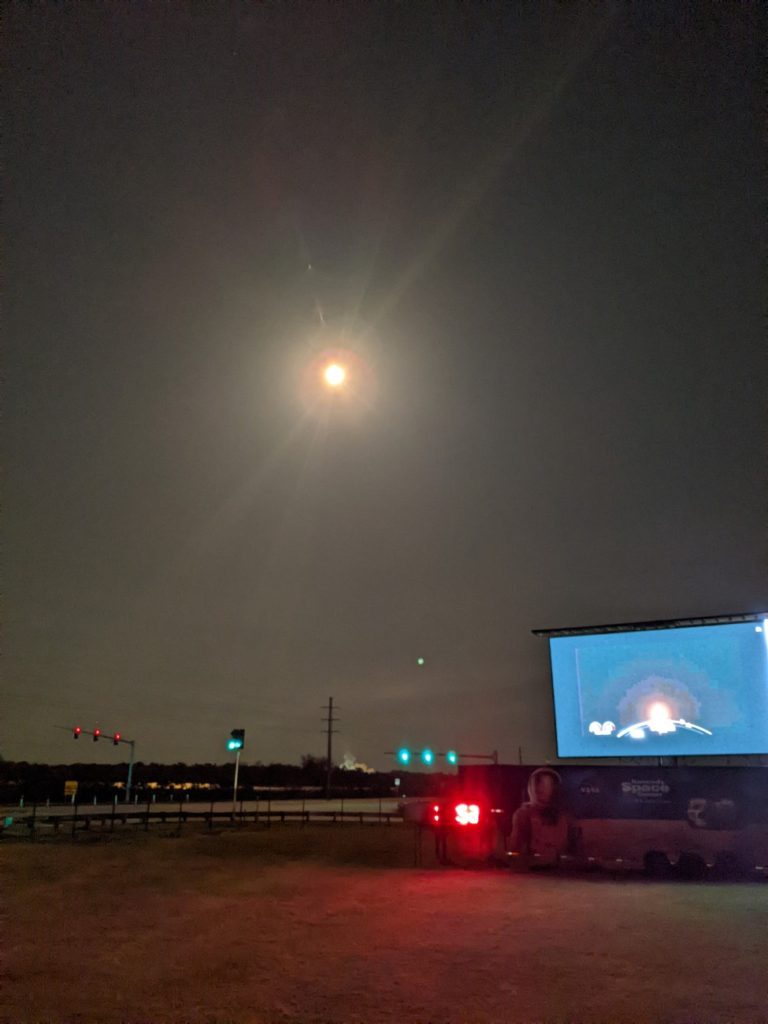
the launch 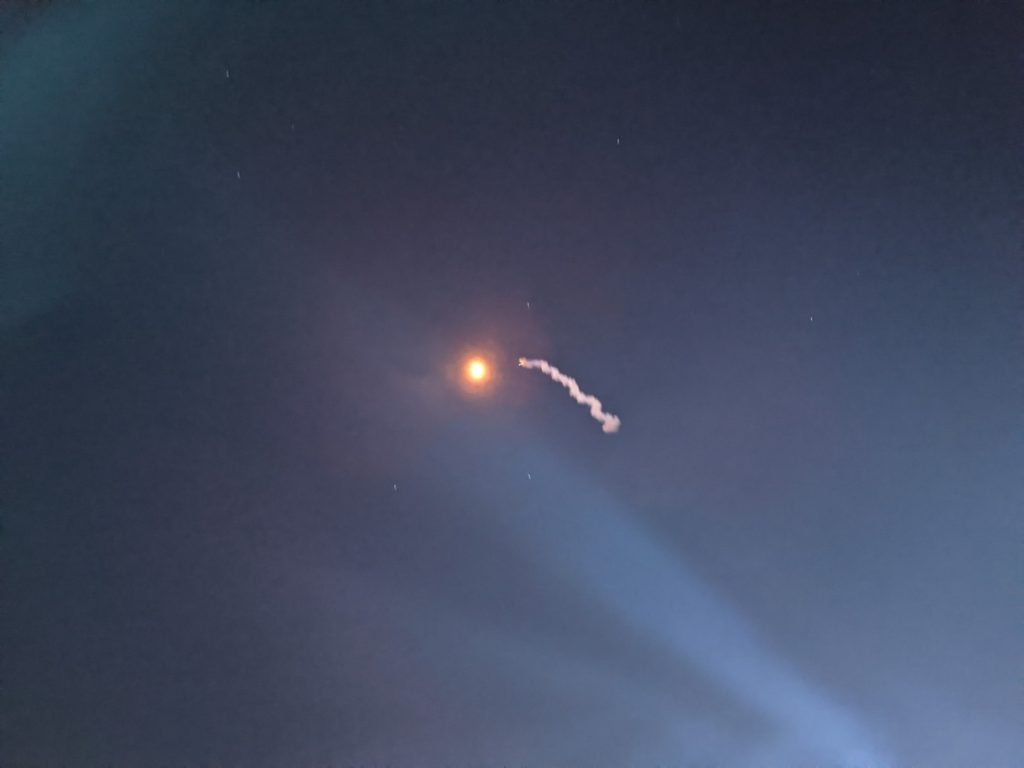
first stage separation
Kennedy Space Center Visitor Complex
I was surprised to find that the Kennedy Space Center isn’t more of a cohesive experience. It’s a collection of separate buildings and experiences to visit in turn, like attractions at a theme park. I’m not sure why I was thrown off by this, but I was. I may have been expecting more of a museum approach.
The Space Center website suggests an itinerary through the complex. It saves the best for last so it’s not a bad plan. (Though I guess if everyone followed it, it would be awfully crowded, with everyone moving through the same areas all day.) When you enter they give you a daily schedule for all the guided presentations for the day, so you can take them in any order. I followed the guide, choosing whatever was next up in the list and saw everything that is currently available by 3:00 in the afternoon. There’s a lot to do in each building but overall, it’s not a big place.
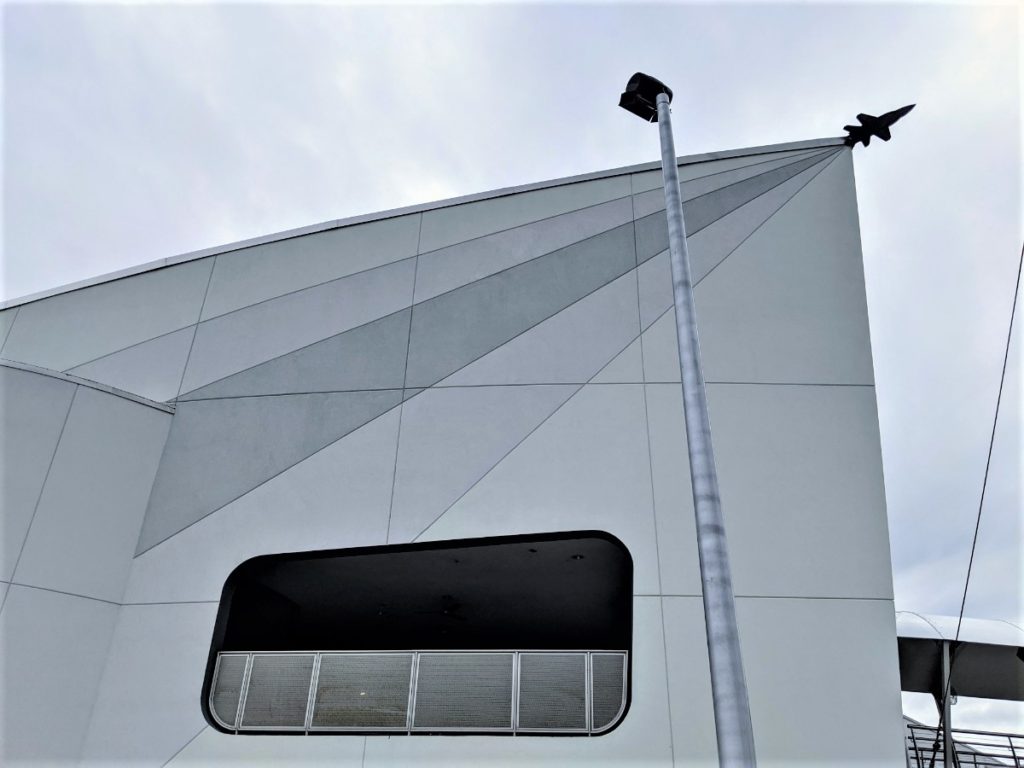
The caveat to that is that bus tours are currently not available. Normally a big part of any visit to the Kenney Space Center, the bus tours take visitors out to the launching pads and the assembly building – all the stuff “out there” that is really the operational part of the huge facility.
However, with my ticket (bought online for the first of October 2020), I received admission for that day, plus complimentary admission for anytime during 2021. So feasibly, if they start offering bus tours again later this year, I can go back and do it all again on the same ticket. (Edit: I did – see below.)
Heroes and Legends
This is the first building on your left as you enter the Kennedy Space Center Complex. There is a Rocket Garden in front, with the real, historic rockets you can walk among. An informative talk is given on these several times a day.
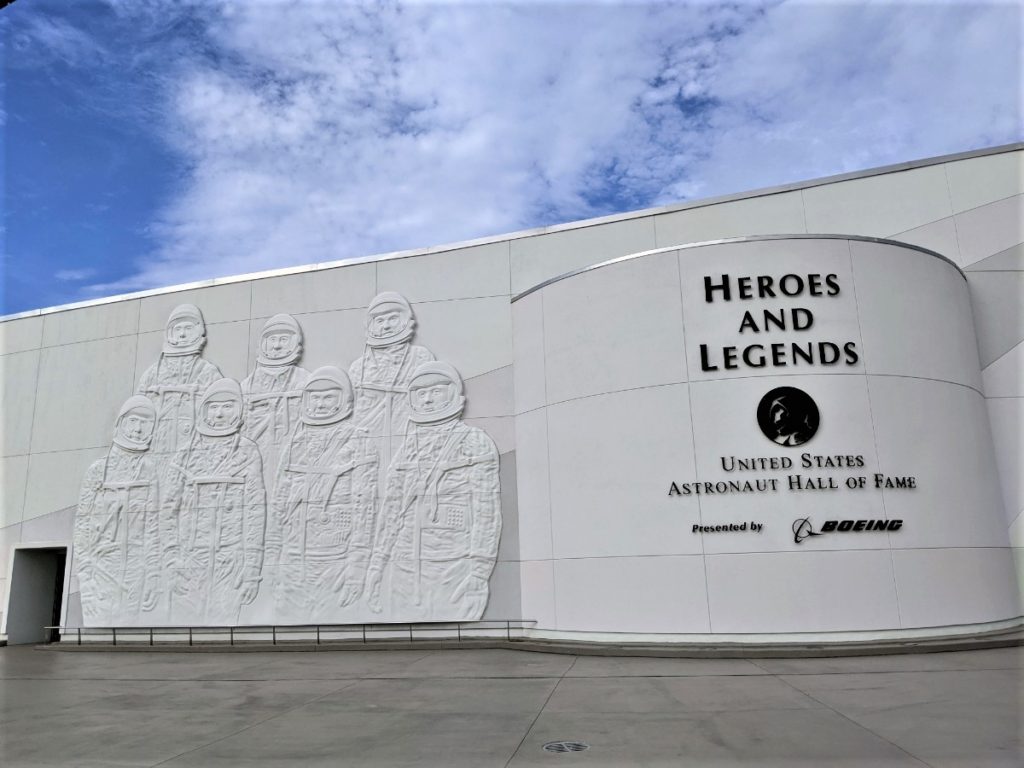
Up the long, swooping ramp and into the building, there’s a multimedia presentation about the progress of the space program and several exhibits on what it takes, the equipment used, and glass etchings of all the astronauts that have ever gone into space.
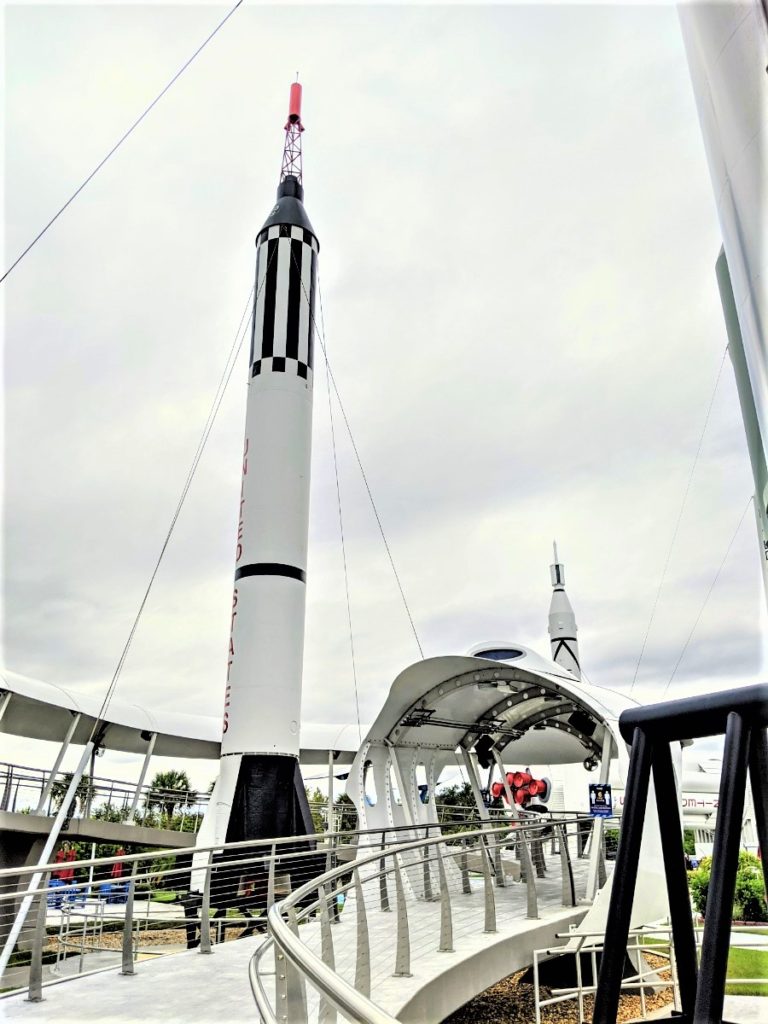
IMAX Theater
There is an IMAX 3D theater showing 40-minute films on the space program. The one I watched is called Journey To Space, about NASA’s accomplishments and narrated by Sir Patrick Stewart of Star Trek fame. (Confession: it took me FOREVER to realize why they chose a British actor to narrate a film about the American space program…) Currently, they are also showing a new film called Asteroid Hunters, narrated by Daisy Ridley of Star Wars fame. Covering all their movie/TV bases, I guess. (Still British.)
EDIT: on my second visit, I watched Asteroid Hunters. Honestly, they’re both very good and worth your time, though I wouldn’t make either your highest priority for a one-day visit. They’re really better as time-killers until your next event. I squeezed a show in that would end after closing time, but left me plenty of time to get to the launch at 6:12.
Either side of the theater contains small exhibit spaces. One side is NASA Now, showcasing NASA’s commitment to exploring Mars. On the other side is an extra-fee gaming experience called Cosmic Quest.
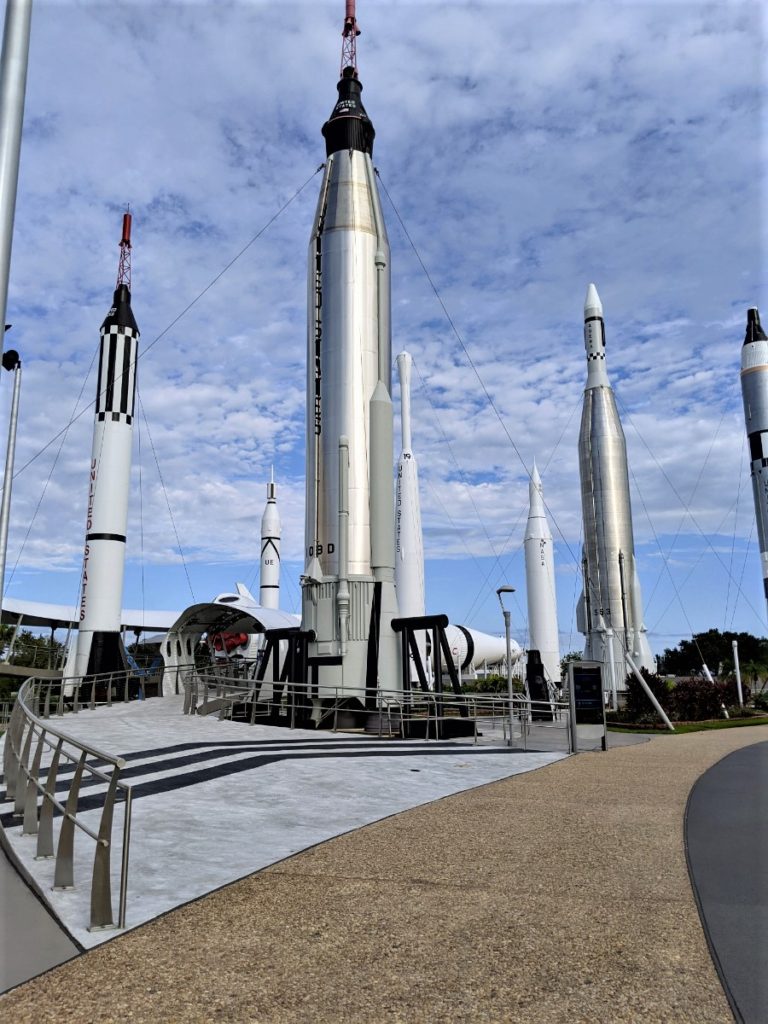
Planet Play
Planet Play is a new addition to the Imax building since I visited. It looks like a well-cushioned, space-themed jungle gym. On my visit, anything you could climb in or slide down was closed off, so I’m not sure how they’re doing with Covid precautions on this new area, but it looks currently open.
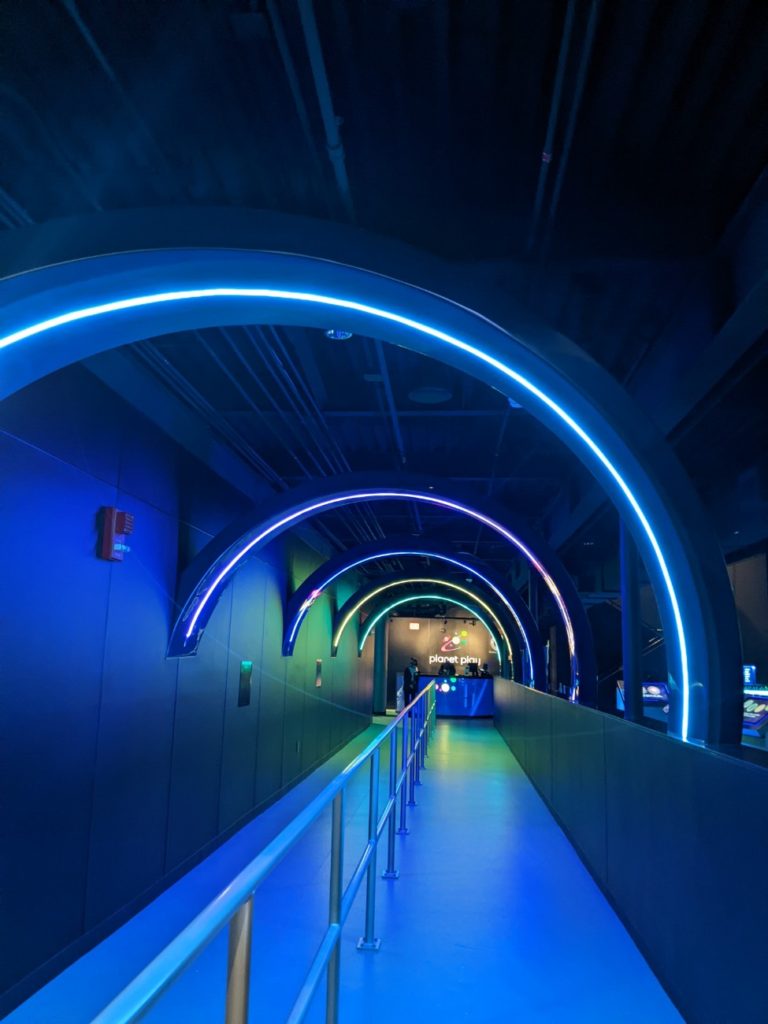
Journey to Mars
To further your knowledge about NASA’s commitment to study Mars, visit this smaller building. There are some cool rovers in here to look at and some interactive elements, all with the idea of “recruiting you to go to Mars.” A show about Mars is held here throughout the day, with some benches for seating.
Universe Theater
If you have some extra time during your day, try to catch a talk at the Universe Theater. They give Mission Status Briefings and other talks throughout the day. It’s very low-key – I listened to a Mission Briefing given by an elderly and very knowledgeable employee/docent and it was far more interesting than I thought it would be! I wouldn’t rank it high on your to-do list, but if you need to sit down in some air conditioning, this will do the trick.
EDIT: during my second visit, watched a presentation called Eyes on the Universe, a guided slide show of images captured by the Hubble Space Telescope. There was also a bit at the end about the just-launched James Webb Telescope which will peer even further into space. Again, it’s very low-key, but I was still blown away by the images and the enthusiasm of the presenter.
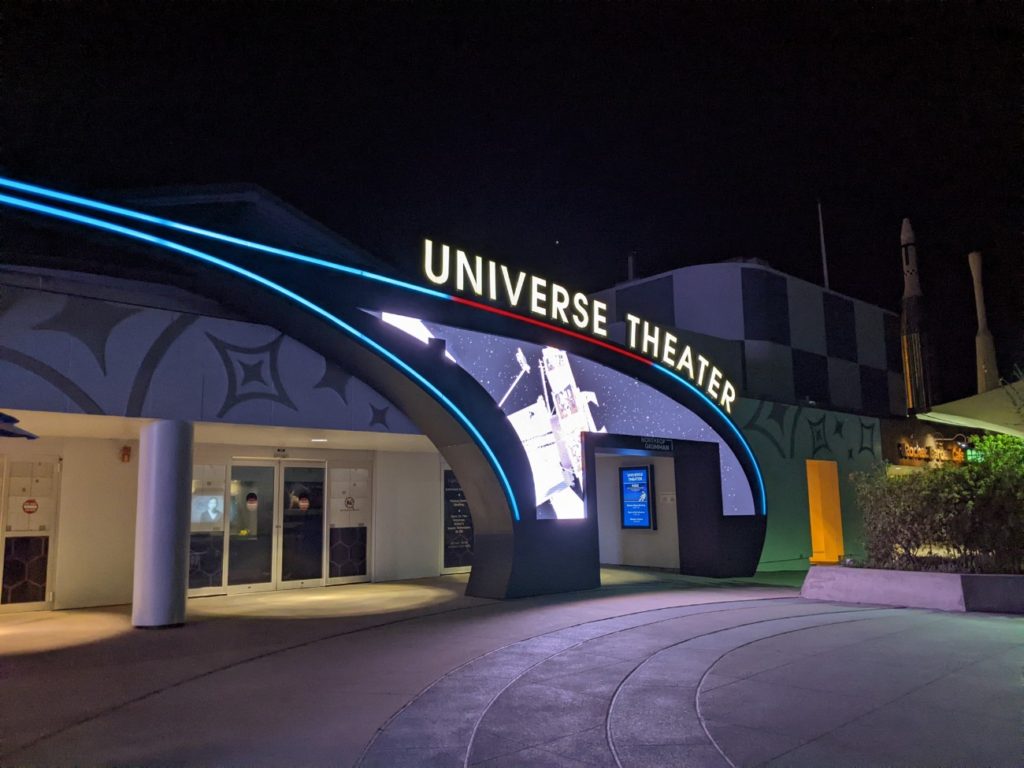
Space Shuttle Atlantis
This huge building in the back of the complex is the granddaddy of all experiences at the Kennedy Space Center. You start in a second-floor projection room that gives a real WOW factor to the reveal of the actual Atlantis space shuttle hanging at an angle in the center of the building. Aside from the Apollo/Saturn V Center, this is the one absolute must-do.
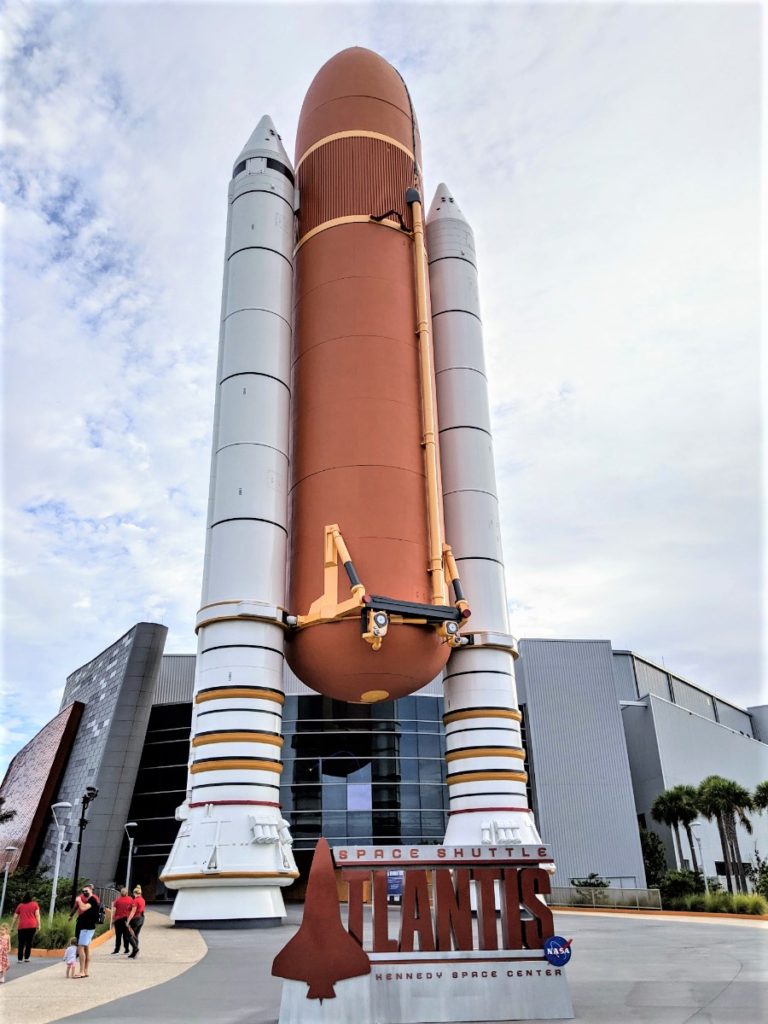
After the theater presentation, you can walk around the shuttle, then down below it and see multiple exhibits along the way. There is a replica Hubble Space Telescope, simulators, and hallways that commemorate astronauts that lost their lives in the pursuit of science. It’s a large building with lots of places to wander around.
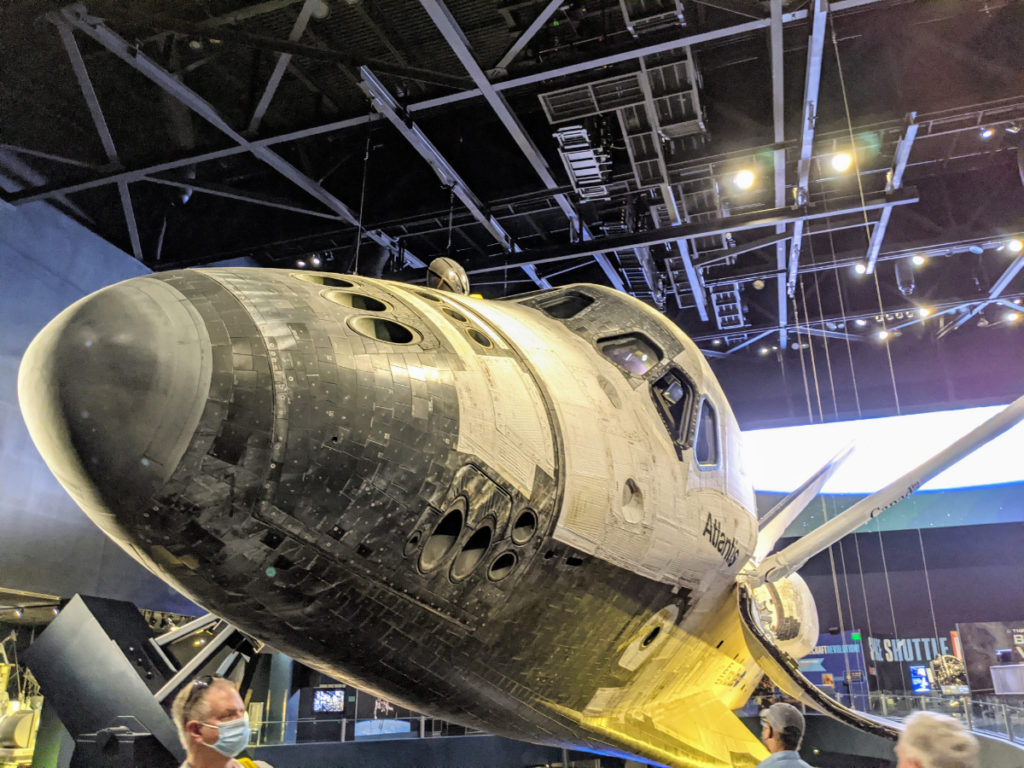
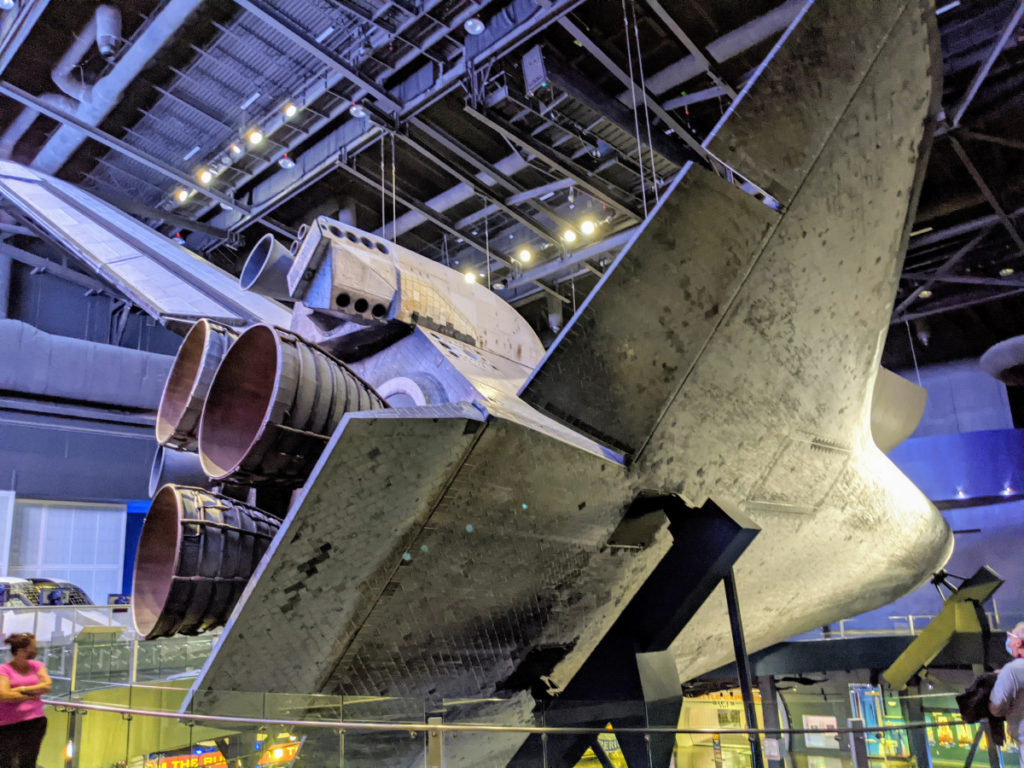
I made the mistake of accidentally joining a tour group at this point. When I exited the theater, there was a gentleman talking about the shuttle, so I followed him around and listened. But then he and the official group (marked by armbands) exited out a back door and left us taggers-along wondering what had just happened! (It was interesting information, though. A guided tour might be worth it!)
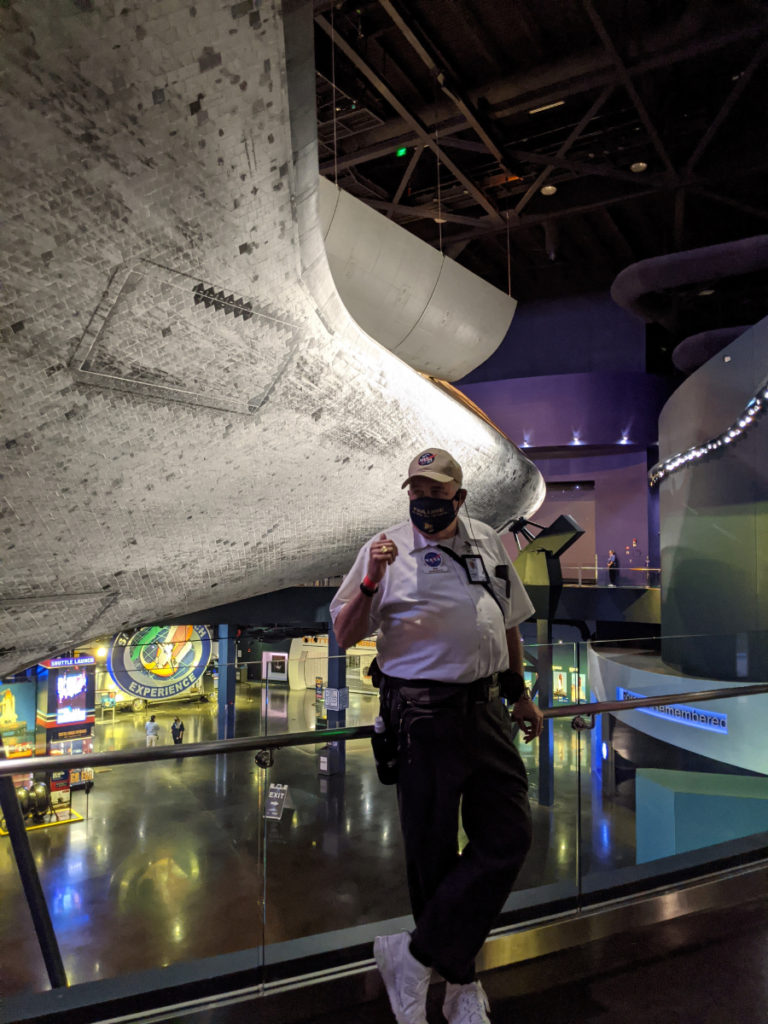
My accidental tour guide 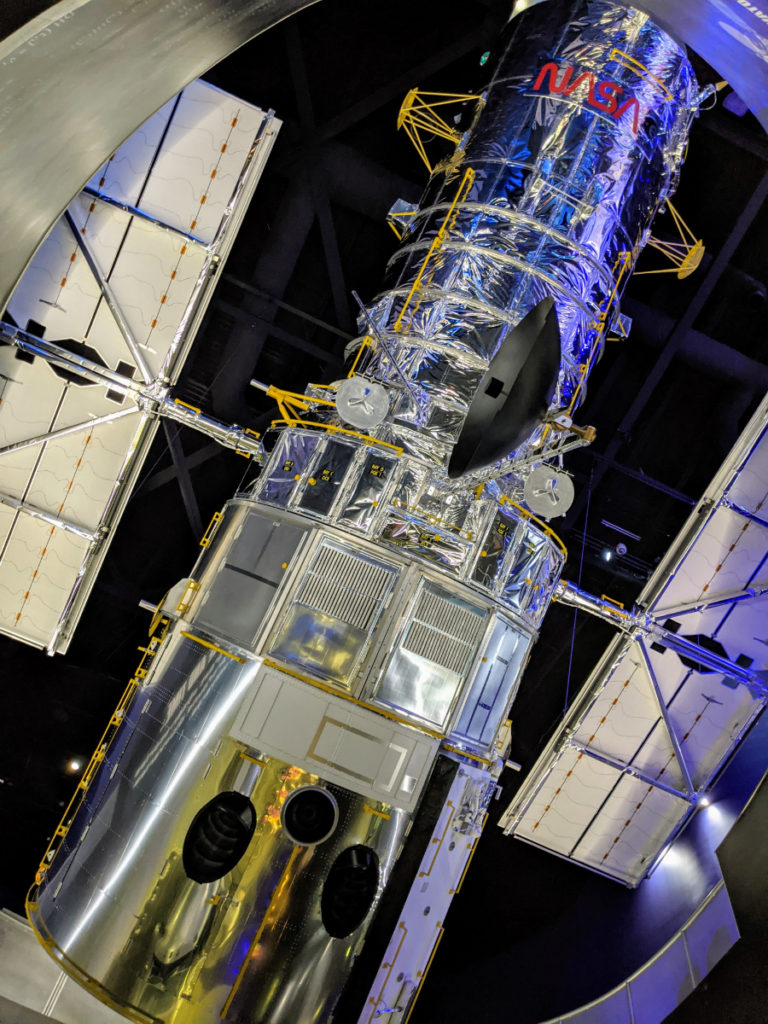
the Hubble Theater 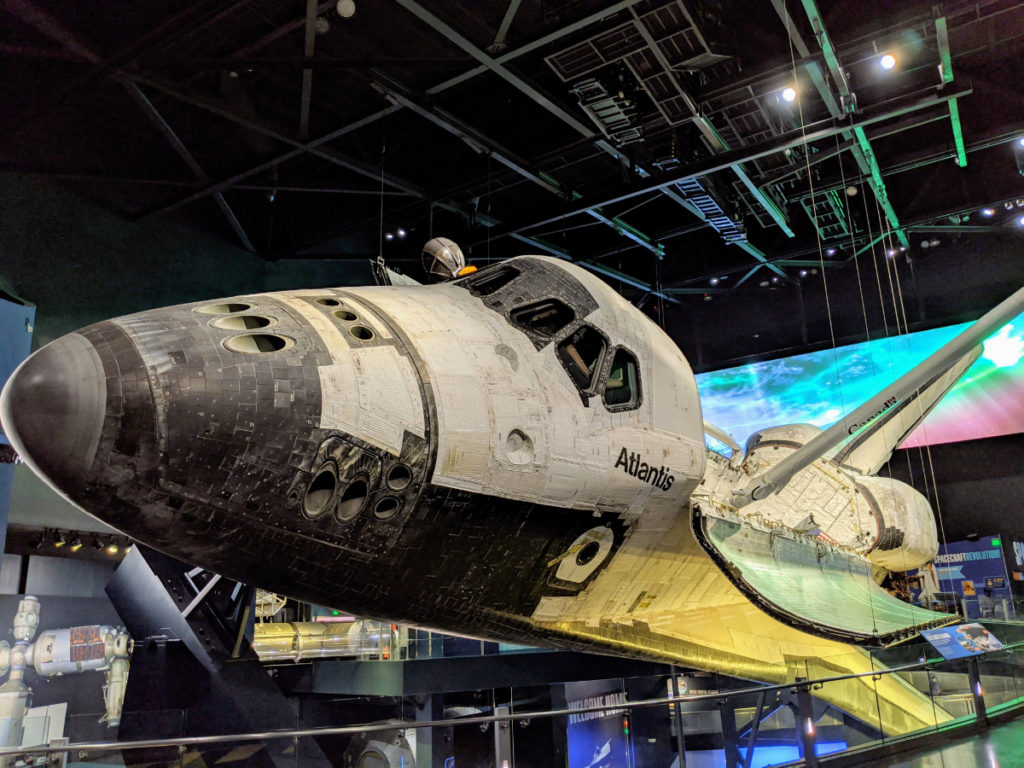
Atlantis
Shuttle Launch Experience
Inside this cavernous building is an actual ride, the Shuttle Launch Experience. You even have to put all your stuff in free lockers like a ride at Universal. The setup is something like Star Tours at Disney, but in the end, it just jiggles you around a bit and tilts you back. It’s mainly just vibration and noise.
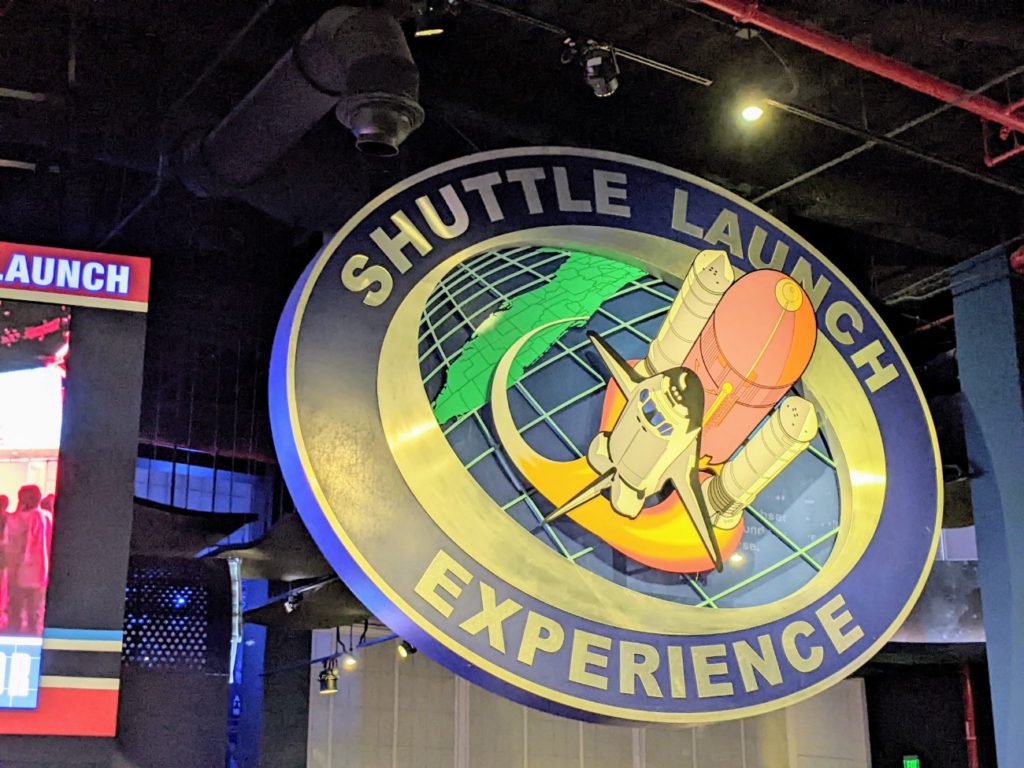
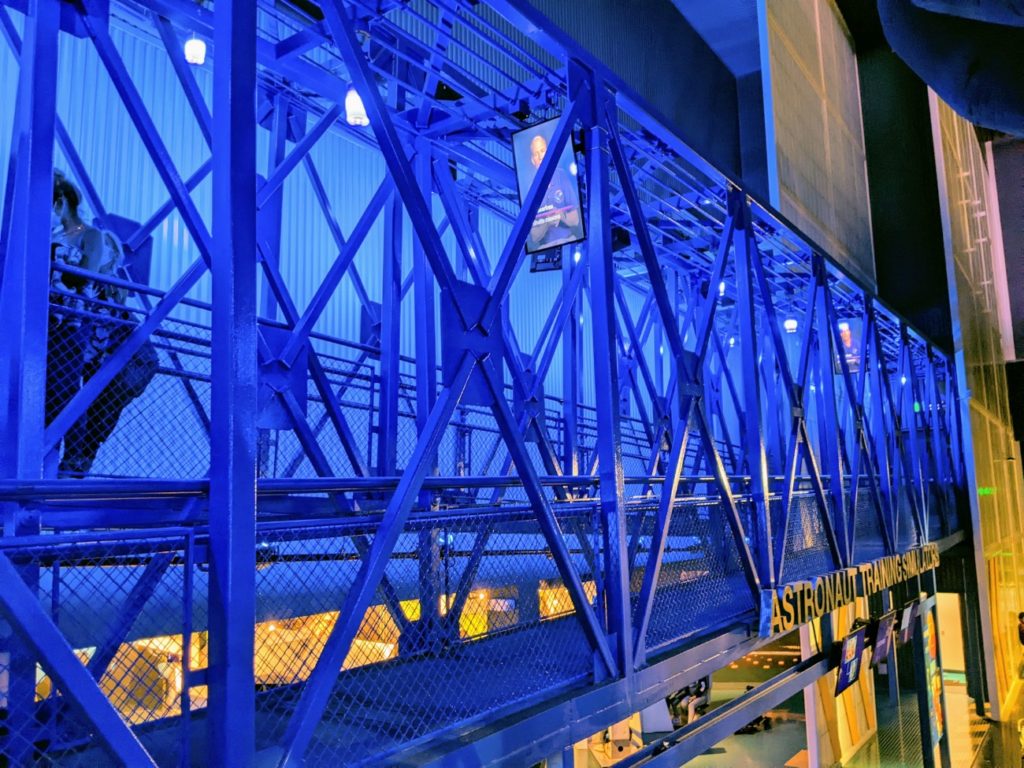
gantry to the show building 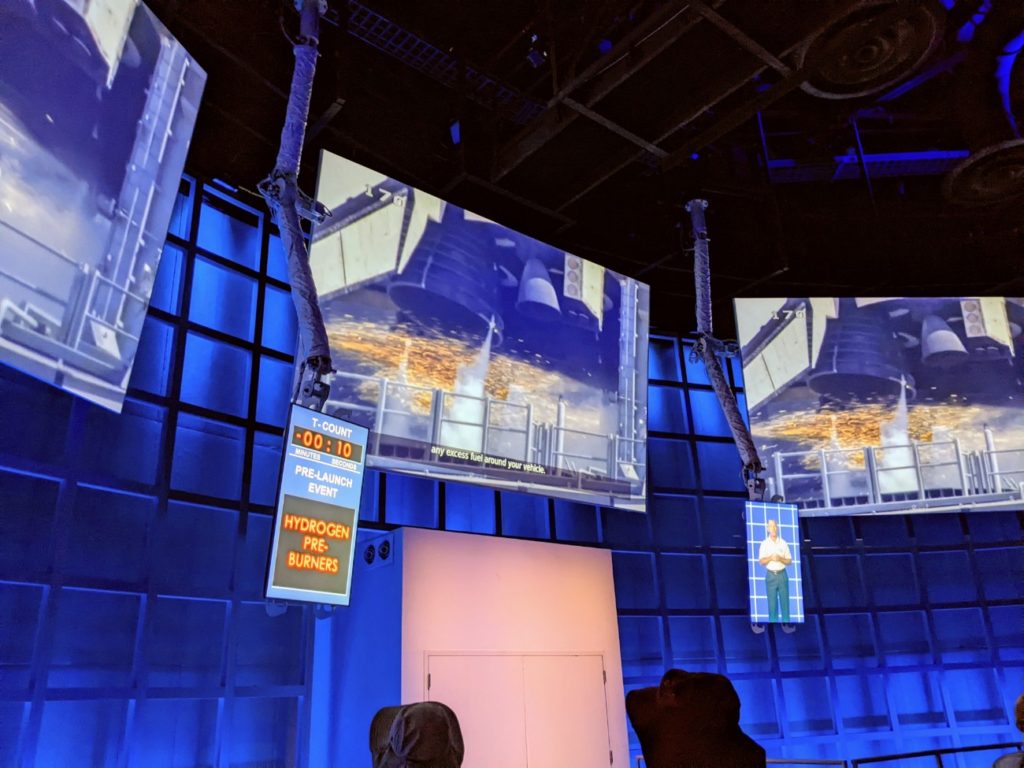
the pre-show 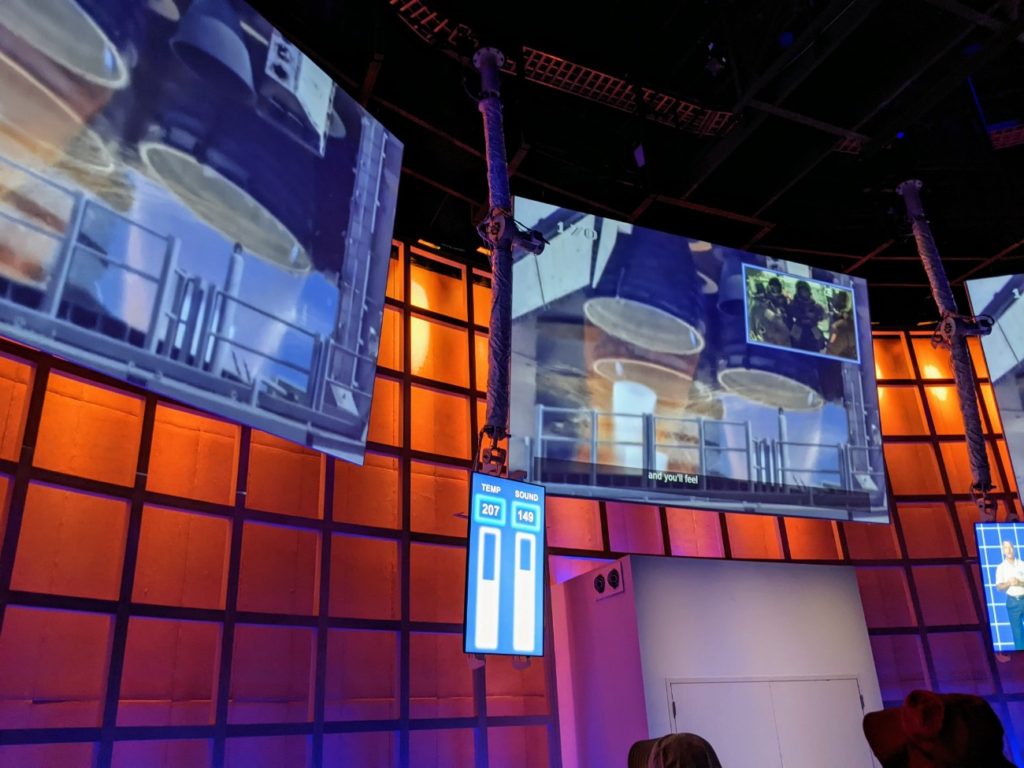
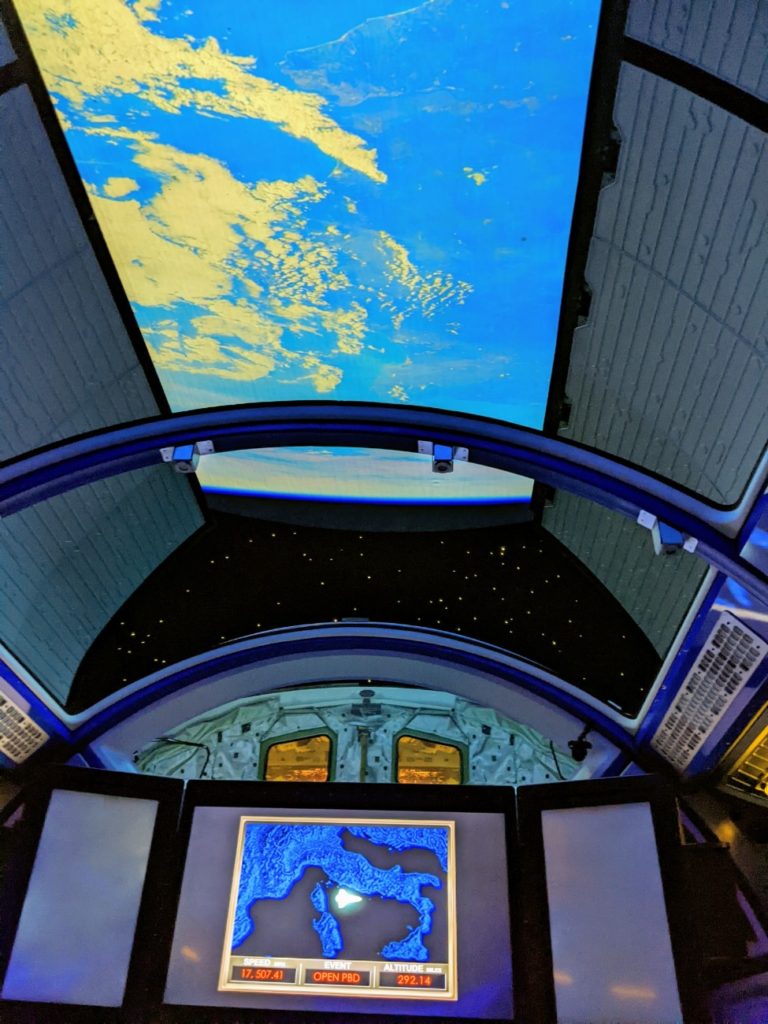
the big finale of your view from the shuttle 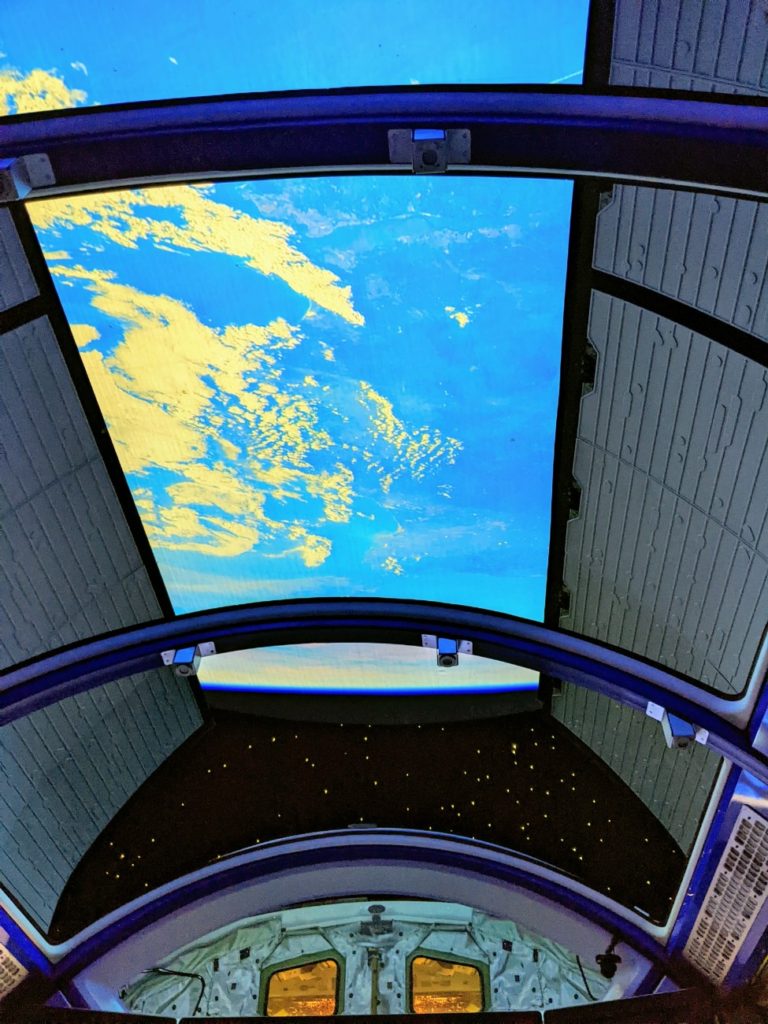
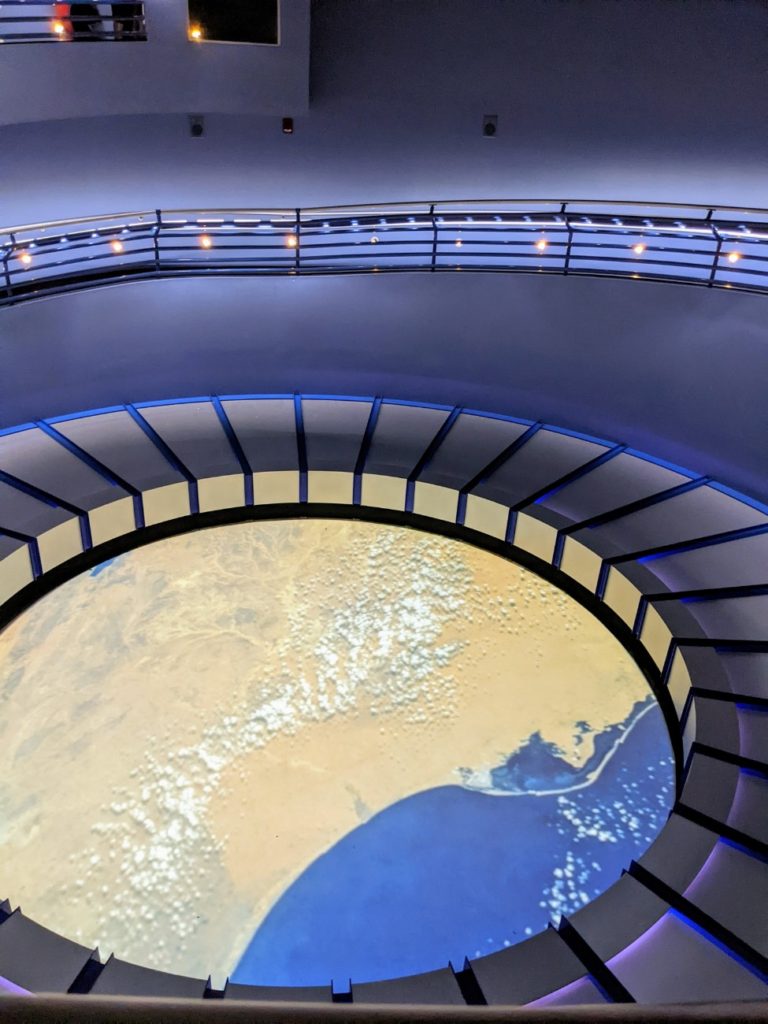
exit ramp overlooking Cape Canaveral
Space Mirror Memorial
The only thing back farther than the Space Shuttle Atlantis building is this large mirror memorial on a pond. It’s out of the way and most people won’t visit it but it’s a nice little walk and a pretty area.
Nature & Technology
There is a little area near the main entrance bathrooms that is a walk-through diorama of a natural setting. (I forget how it ties into technology.) It’s delightfully old-school.
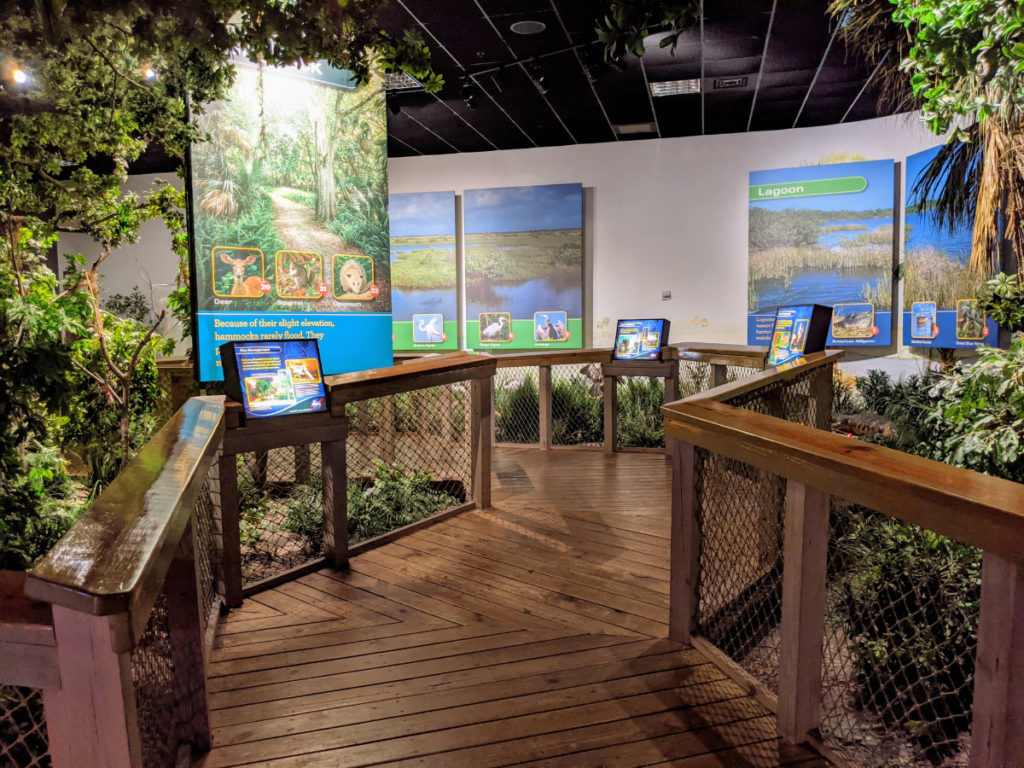
Shopping & Dining
There’s one main restaurant at Kennedy Space Center, the Orbit Cafe. It serves burgers and chicken fingers and has a good selection of salads. Otherwise, you can get snacks in the Imax theater, the play area, and at a Dippin Dots location.
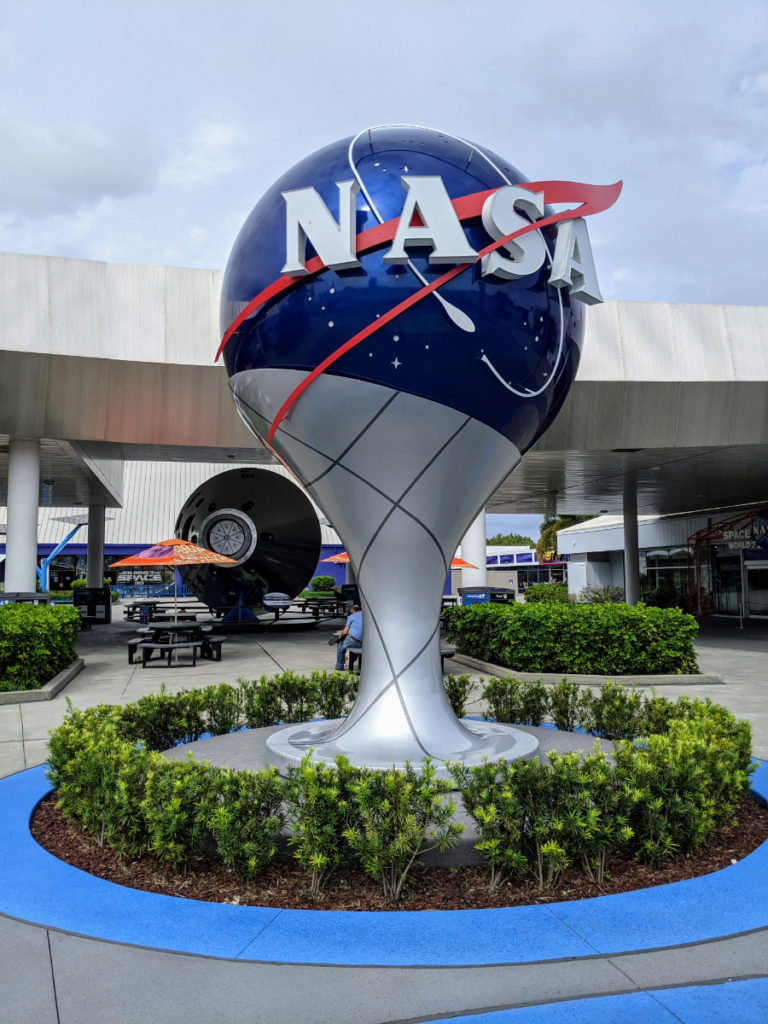
Likewise, there is one large gift shop with two floors of clothes, books, and all sorts of interesting science toys. Naturally, I went home with some space ice cream.
EDIT: Apollo/Saturn V Center & Bus Tour
During my first visit, the bus tours were completely shut down with no way to visit the Apollo/Saturn V Center. A year later, you can take the bus, but it’s just straight there and back. There used to be more of a tour of the old pads with a guide on board and that still hasn’t come back, though the bus drivers can’t seem to help but share information along the drive anyway. The biggest site along the way is the huge Vehicle Assembly Building
You must reserve a spot on a bus, which you can only do once you arrive at the main gate. During my Thursday visit, the park opened at 9 am, I arrived at 10:15, and was able to get a reservation for one for 10:30, so I pretty much just walked right on. Depending on the current Covid situation, be mindful that you stand in a big crowd to wait to board the busses, and they don’t skip seats inside, though masks are required.
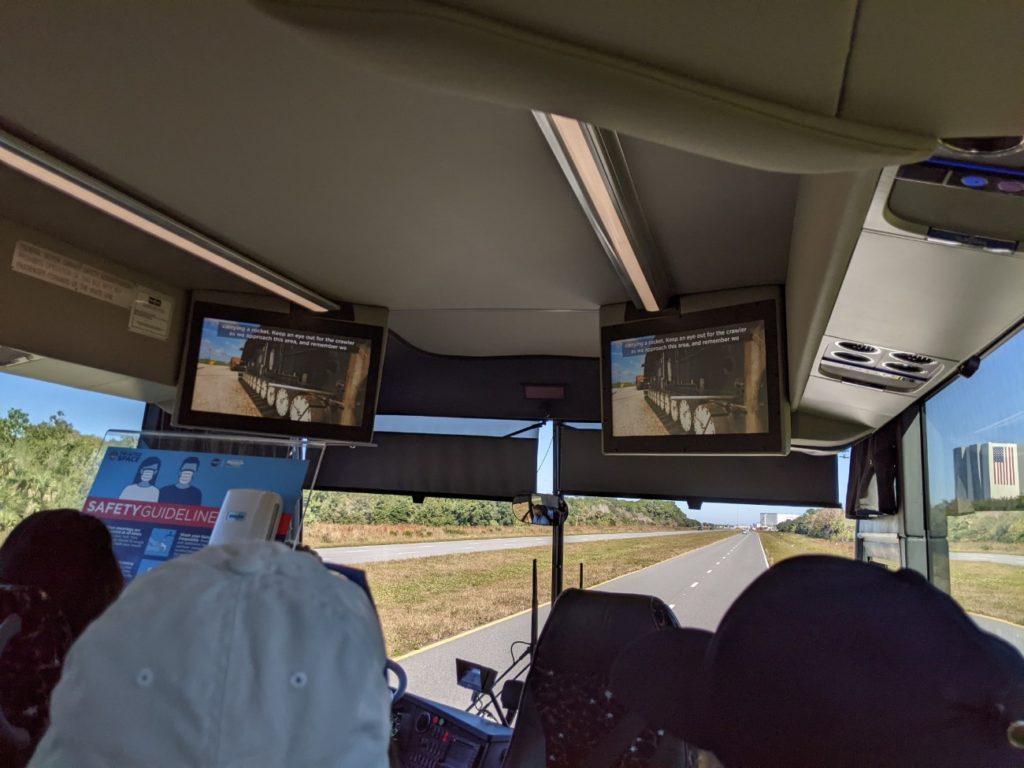
on the bus 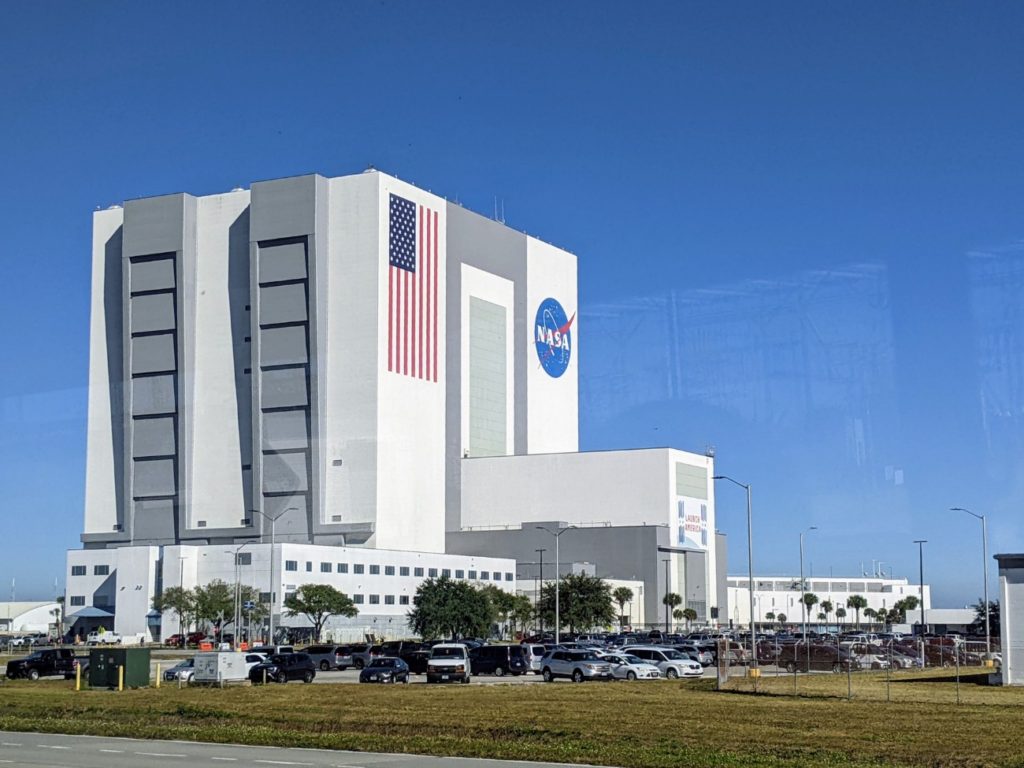
the vehicle assembly building
Apollo 8 & The Firing Room
Again, once you are let off the bus, you are held in a crowd before the doors to the Apollo 8 experience open, then held in a pre-show room, though here, there’s a bit more room to spread out. The next stop is a theatrical Firing Room experience with lots of seating.
Here, you get to experience what it was like in the control room for the first manned Saturn V rocket launch to orbit the moon. You face the actual control panels used at the time, see footage from the launch on several screens, and feel the power of the takeoff via the rattling windows behind you.
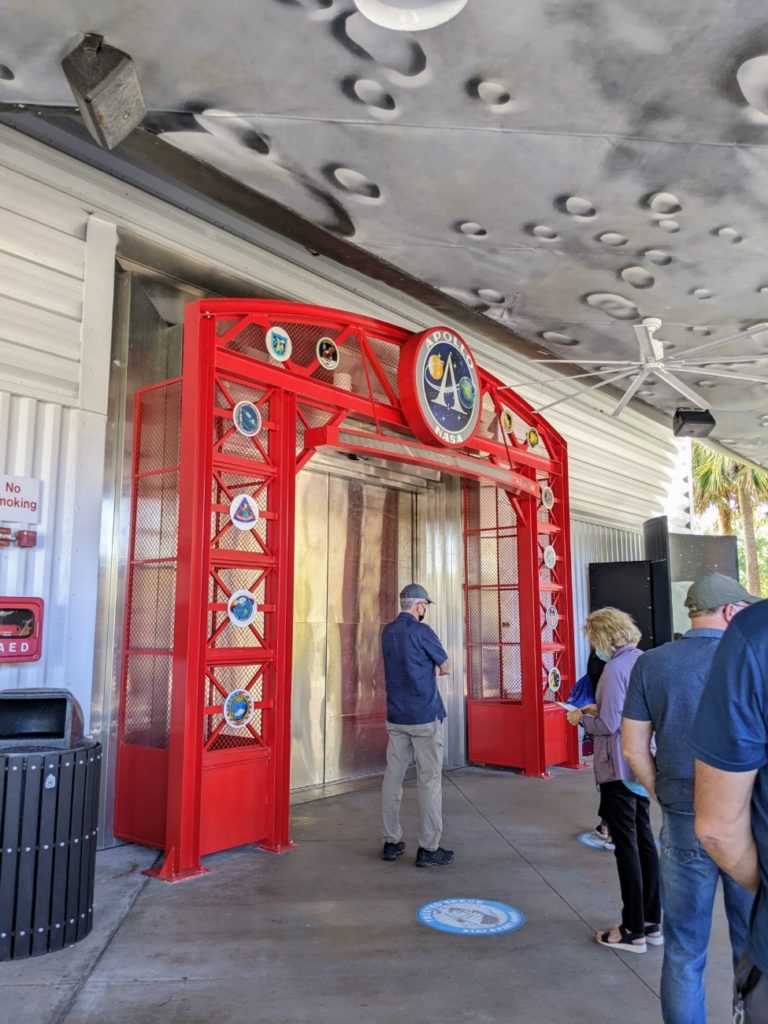
waiting to enter 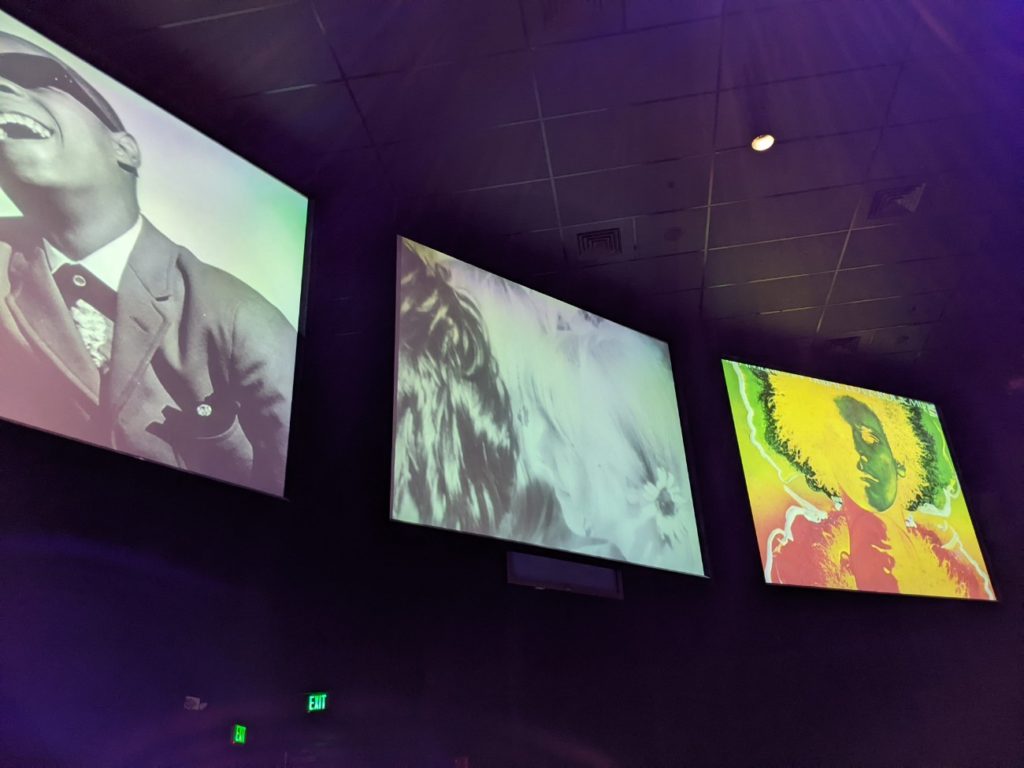
the 60’s in the pre-show 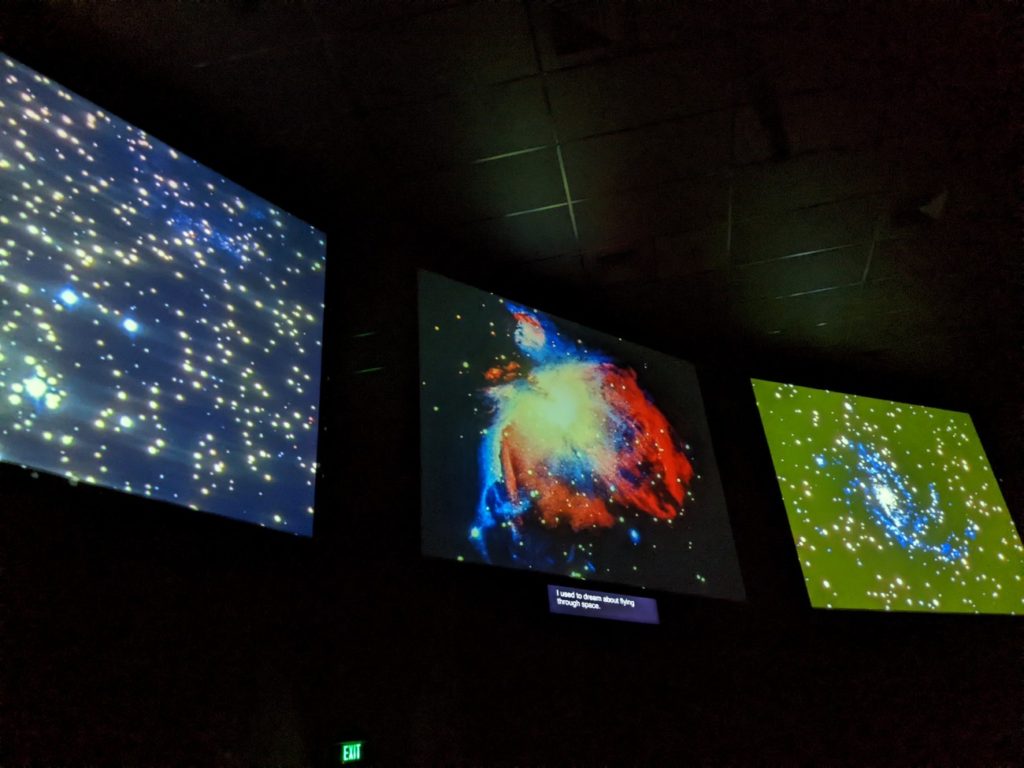
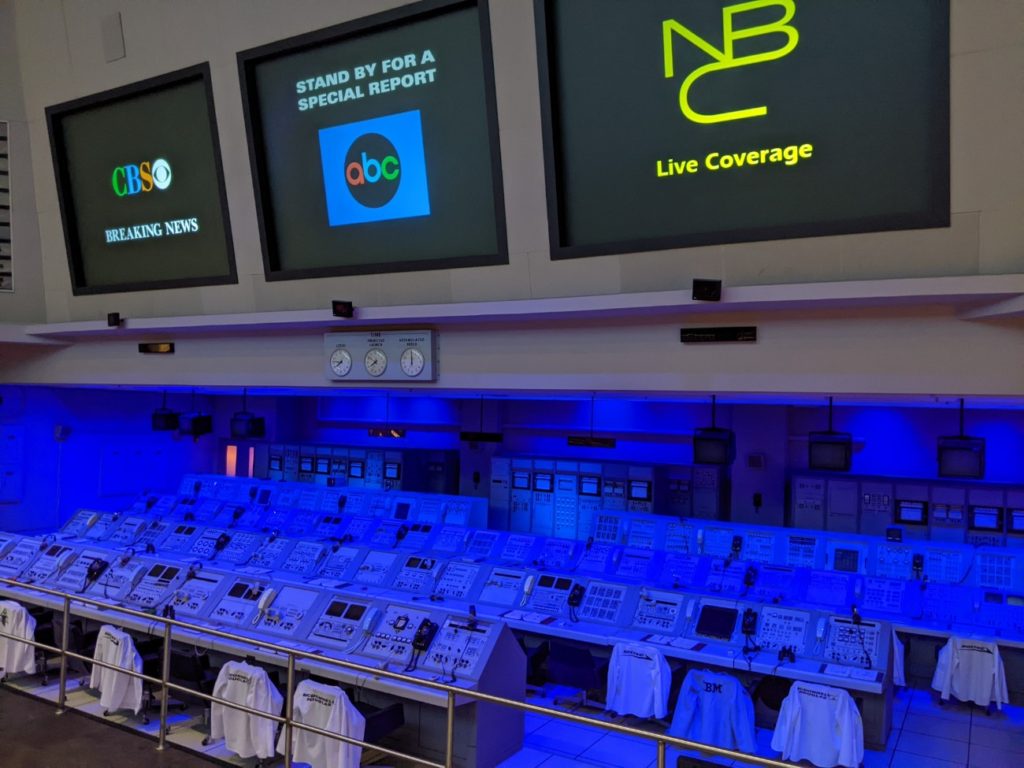
the Firing Room 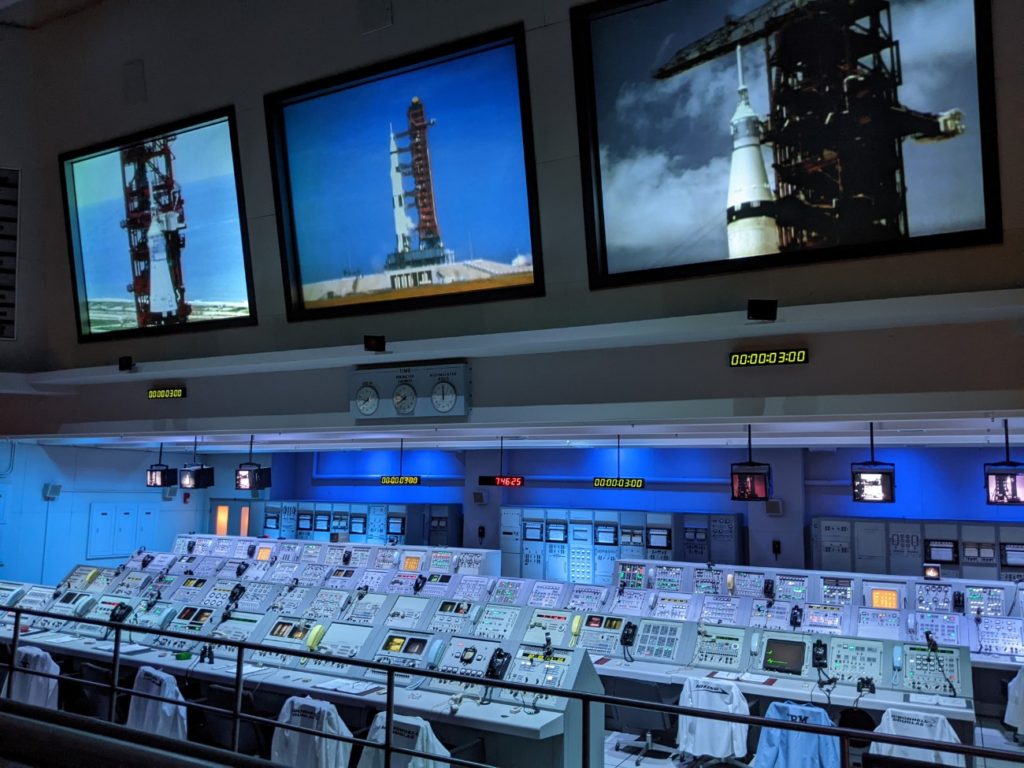
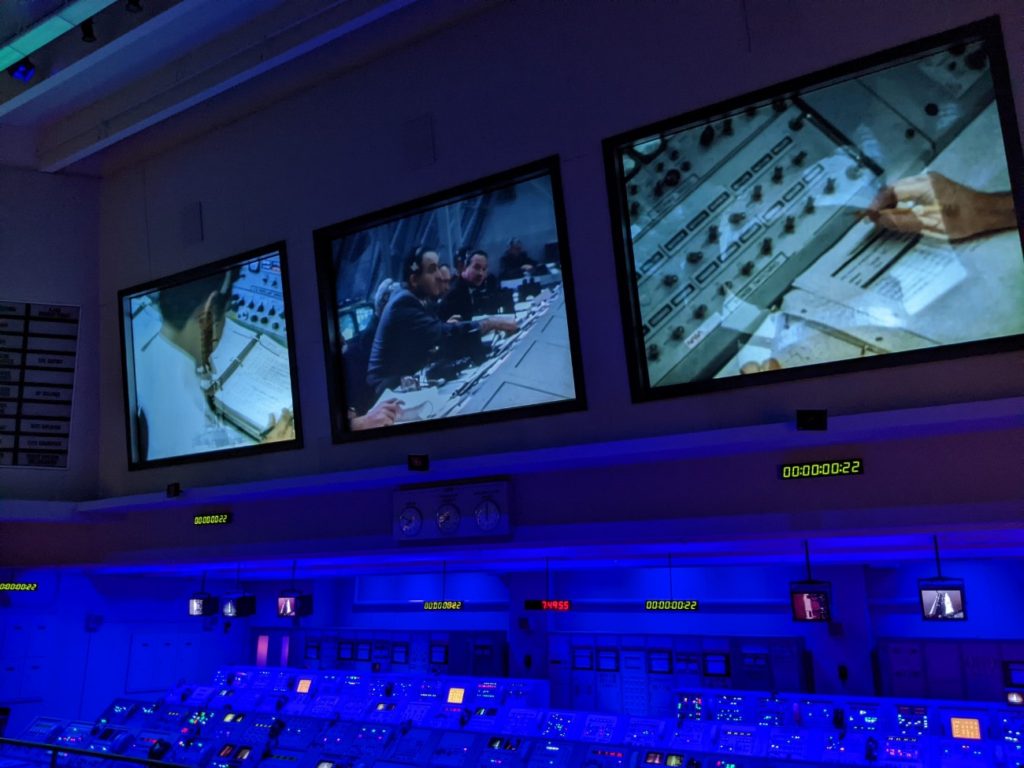
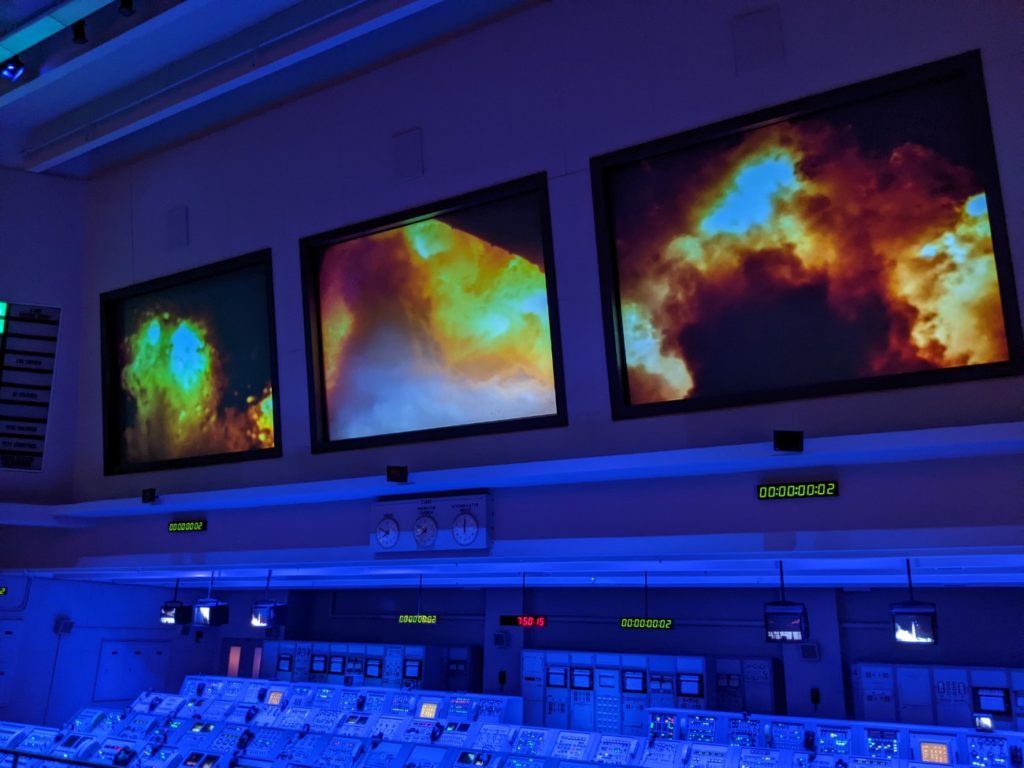
blast off! 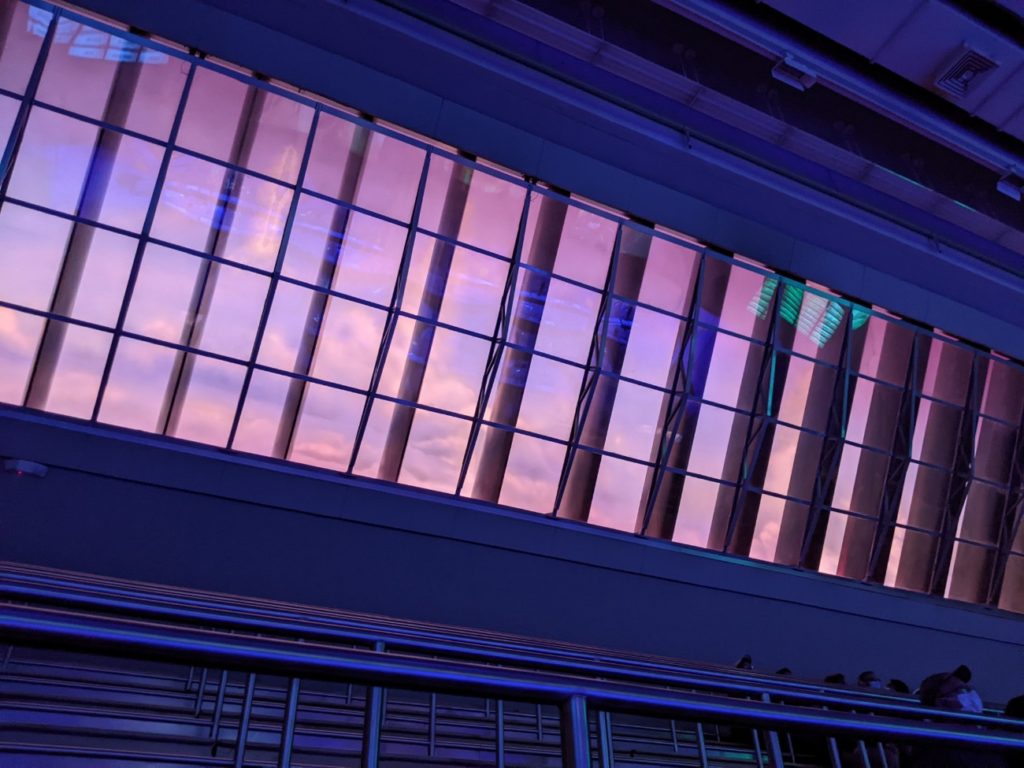
make sure to turn around and notice the windows
Saturn V Rocket
NOTE that there are small bathrooms near the exit of the Firing Room, but there are bigger and less crowded bathrooms at the far end of the hangar.
You exit the Firing Room into a huge hangar housing the actual Saturn V rocket. Around the long room are several displays, many of which are touch screens where you can explore what it was like on the moon, and what it took to get there. At the far end are some lunar vehicles and a large display of a moonscape, complete with a landing module, an American flag, and two astronauts.
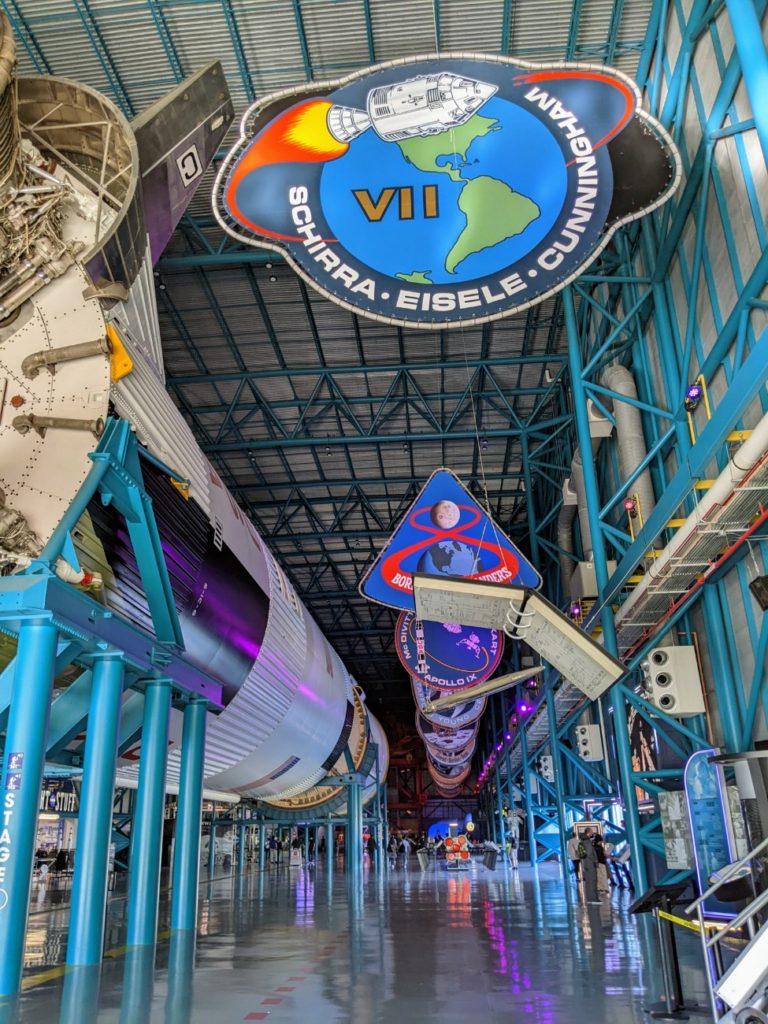
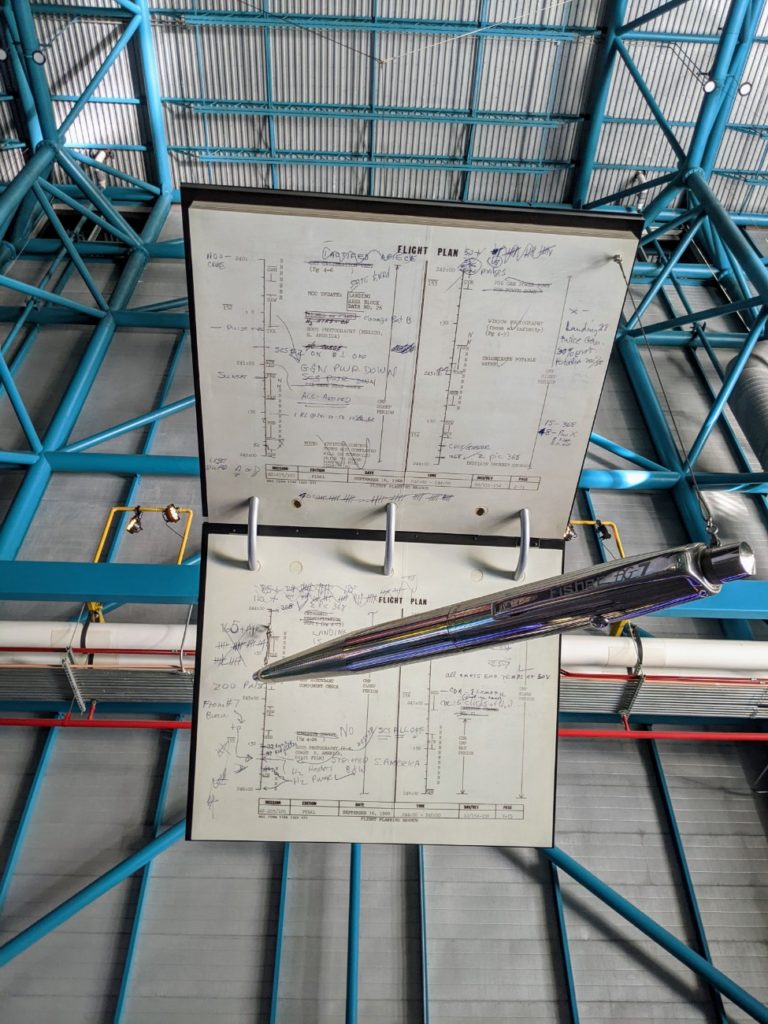
pens in space! 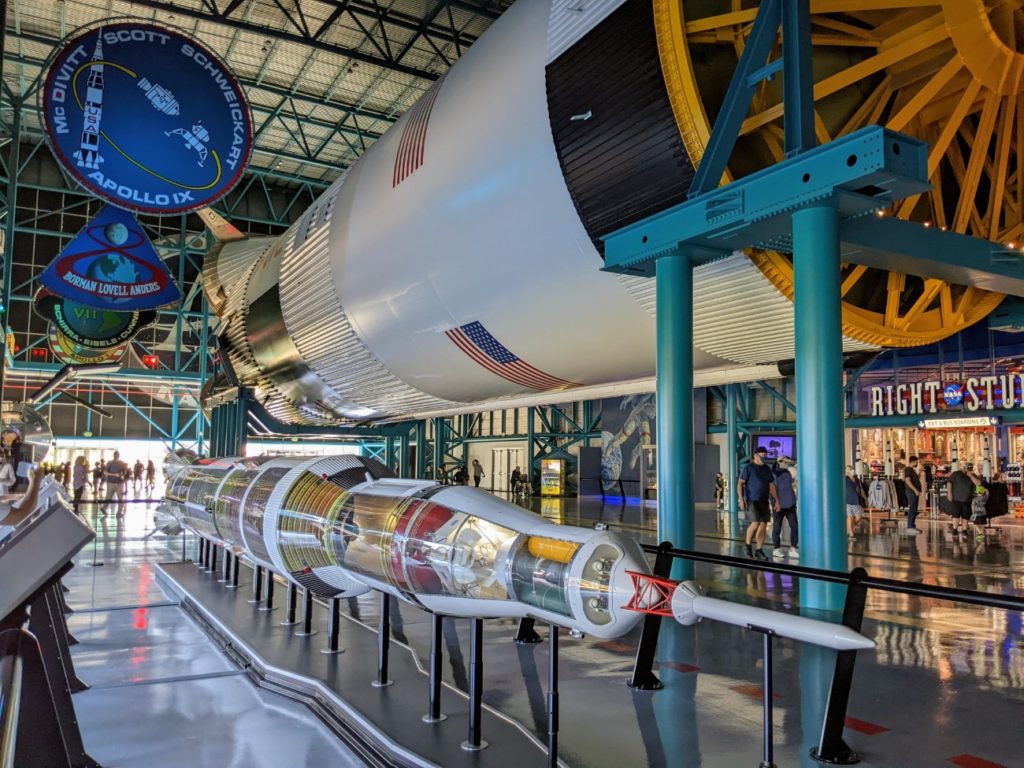
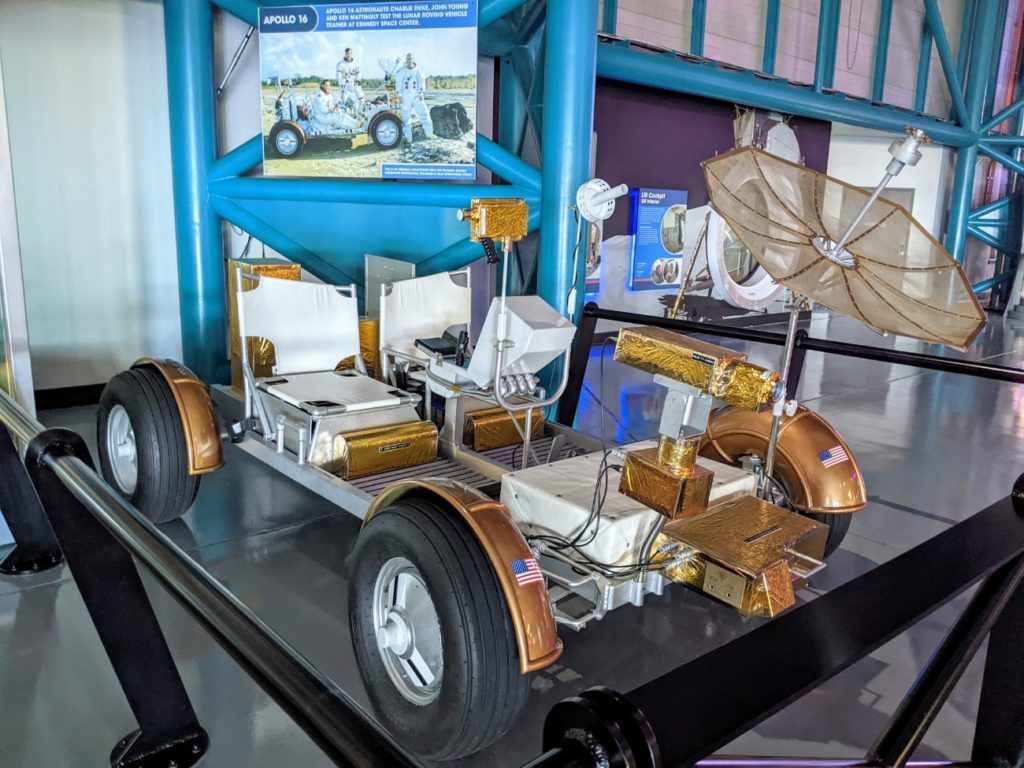
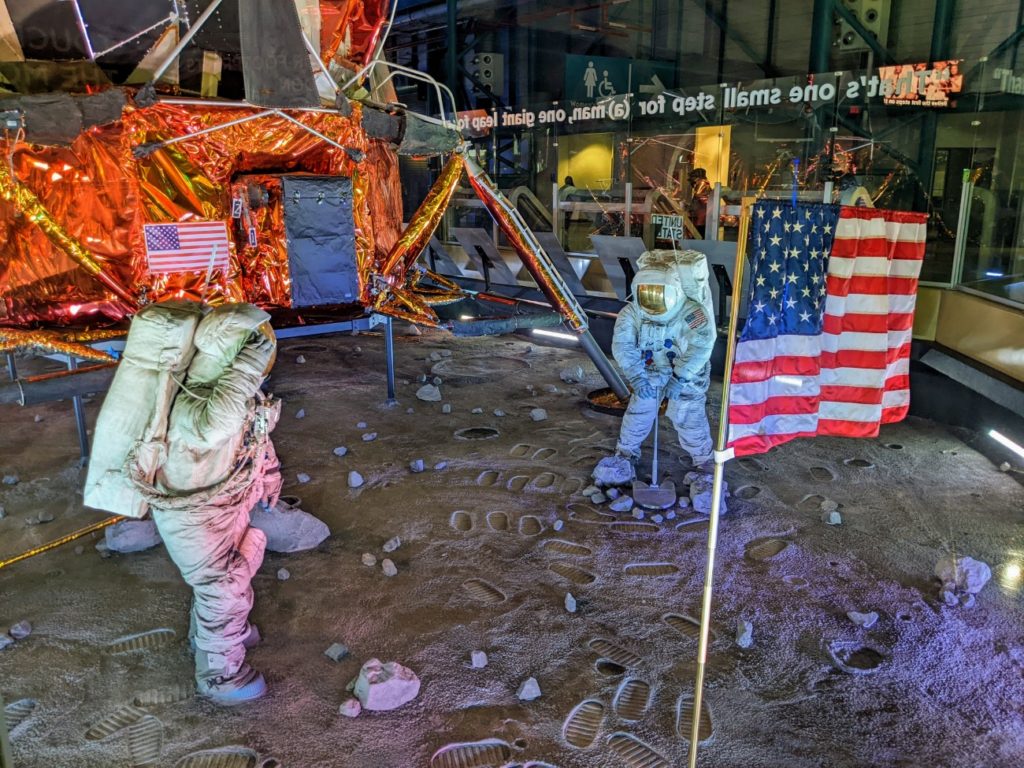
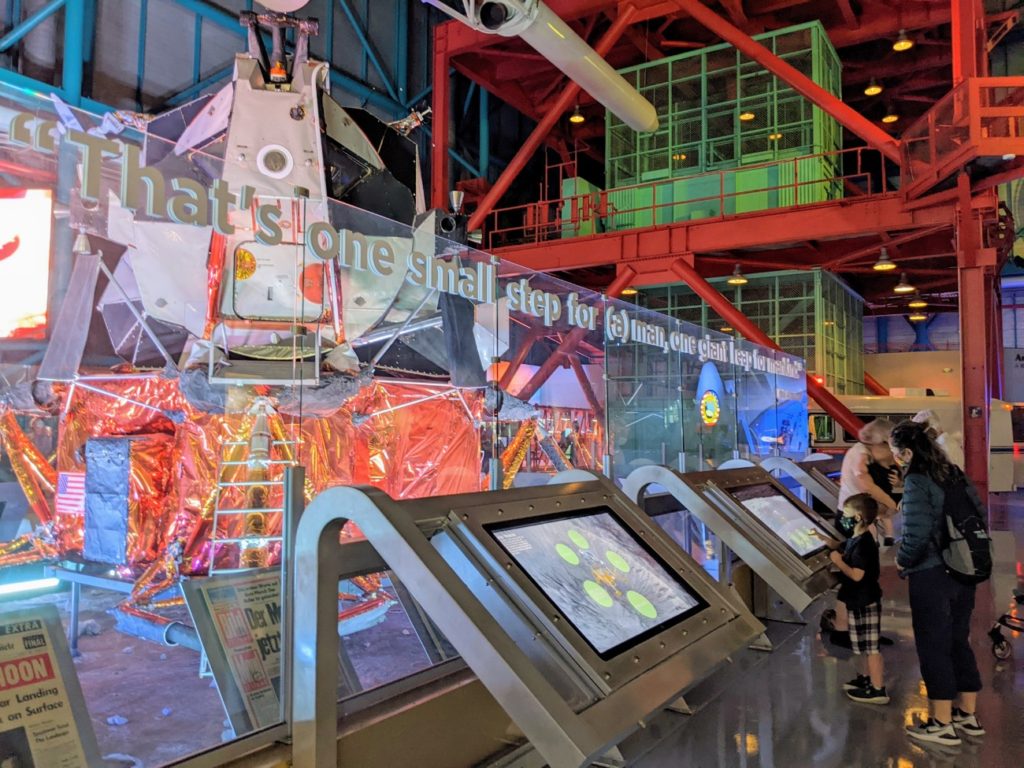
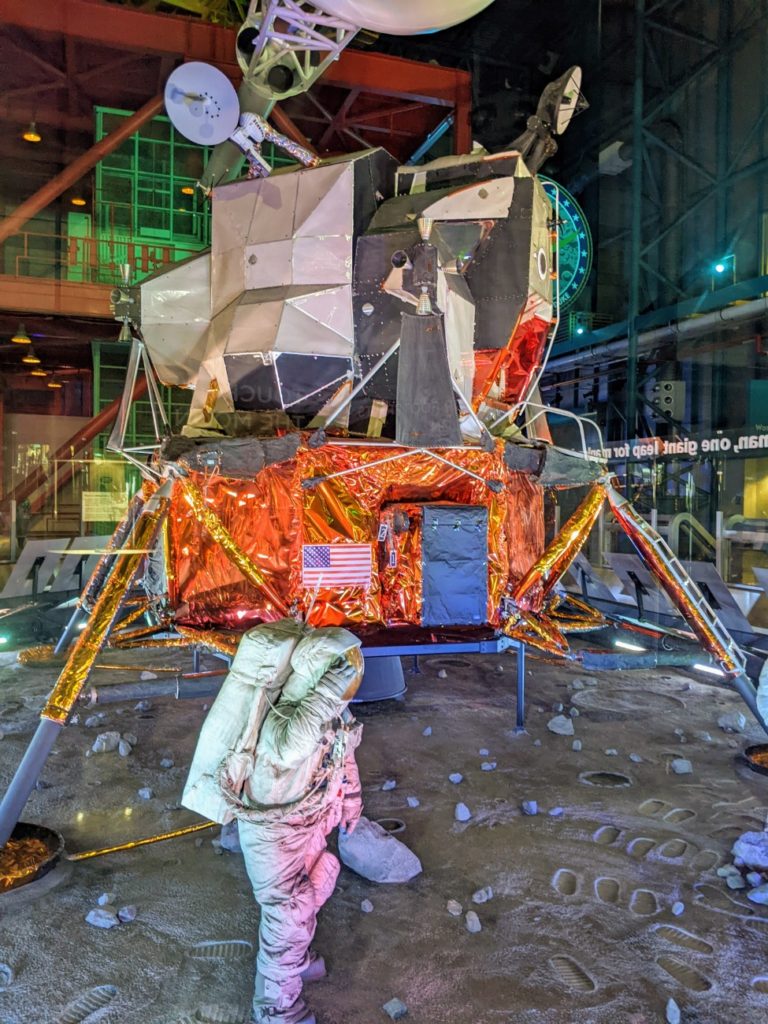
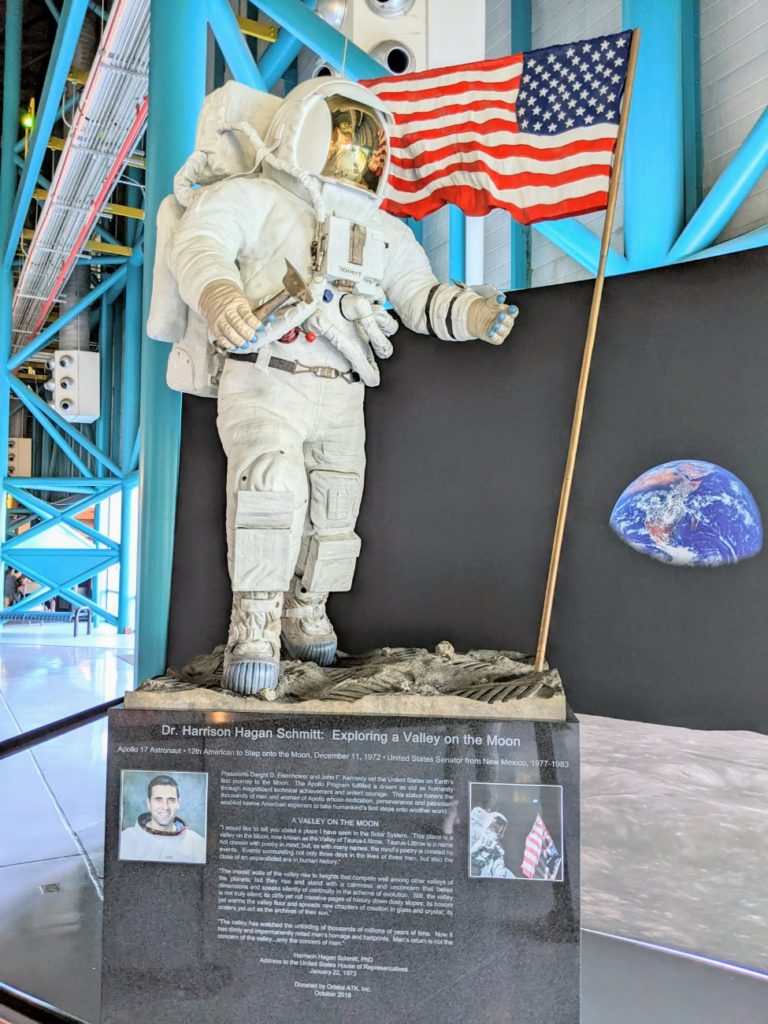
My favorite display is a holographic astronaut. Via a touch screen, you can choose your astronaut and what questions to ask. It looks like there are two of these displays, but only one worked during my visit. At several intervals during the day, there is a guided talk about the rocket itself.
Ad Astra Per Aspera
At the far end of the Saturn V building is an impressive walk-through tribute to the three astronauts that died during the Apollo 1 missions – Gus Grissom, Ed White and Roger Chaffee. The displays are really neat – I especially like the three cases that alternate between the information shown on the glass to the artifacts for each man inside. “Ad Astra Per Aspera” is Latin for “through hardships to the stars”, and cements the sacrifices made to get man to the moon.
Lunar Theater
The Lunar Theater, also at that end of the building, is a theatrical presentation of the landing on the moon. The effects aren’t that stunning – at one point an astronaut pops up through the floor – but you can really feel how fraught that first landing really was. I don’t think I knew how much went wrong before they could land.
After the presentation, you empty into a gallery featuring actual treasure from the Apollo 8 mission, like a spacesuit covered in moon dust and the actual capsule in which they all crashed back to earth.
Outside Spaces
Exiting the front of the building by the Saturn V’s engines, you pop outside to the Moon Tree Garden, featuring a sculpture and trees planted from seeds that have been to the moon.
There’s a large cafeteria/cafe with pizza, chicken tenders, salads, and sandwiches in the middle of the building. You can eat at tables inside or go outside where there are a few picnic tables and a large lawn. The lawn and some nearby bleachers are used during launches since some of the SpaceX launch pads are just across the water.
To exit the building and reboard a bus back to the main complex, exit through the gift show at the center of the building, opposite the cafe.
Tickets & Extras
The basic daily admission ticket to the Kennedy Space Center is $57 or $47 for kids 3-11. Parking costs $10 per car. If you think you’ll want more than one day, a pass good for a year only costs $25 more at $82/$67. This also gets you one free parking voucher (to use within 30 days) and 10% off admission for up to 6 other people per visit.
An annual pass with always-free parking, 10% off for guests, and 10% off shopping and dining costs $96/$78. If you want to go all-out, a $146/$116 ticket also gets you a meal with an astronaut, a tour, and a collectible (this option is currently unavailable.)
A 3-hour guided tour (like the one I ran into) costs only $20. A game of Cosmic Quest costs $8.99. Then there’s a $175 Astronaut Training Experience, a 5-hour program for people ages 10 and up. Ages 10-17 will need a paying adult along, however. Apparently, it’s not quite Space Camp. You don’t need regular admission to the rest of the park, however.
When Covid restrictions lift, there is also an array of Mars training experiences. A day at Mars Base 1 costs $150, a Mars simulator costs $40, and a spacewalk simulator costs $30.
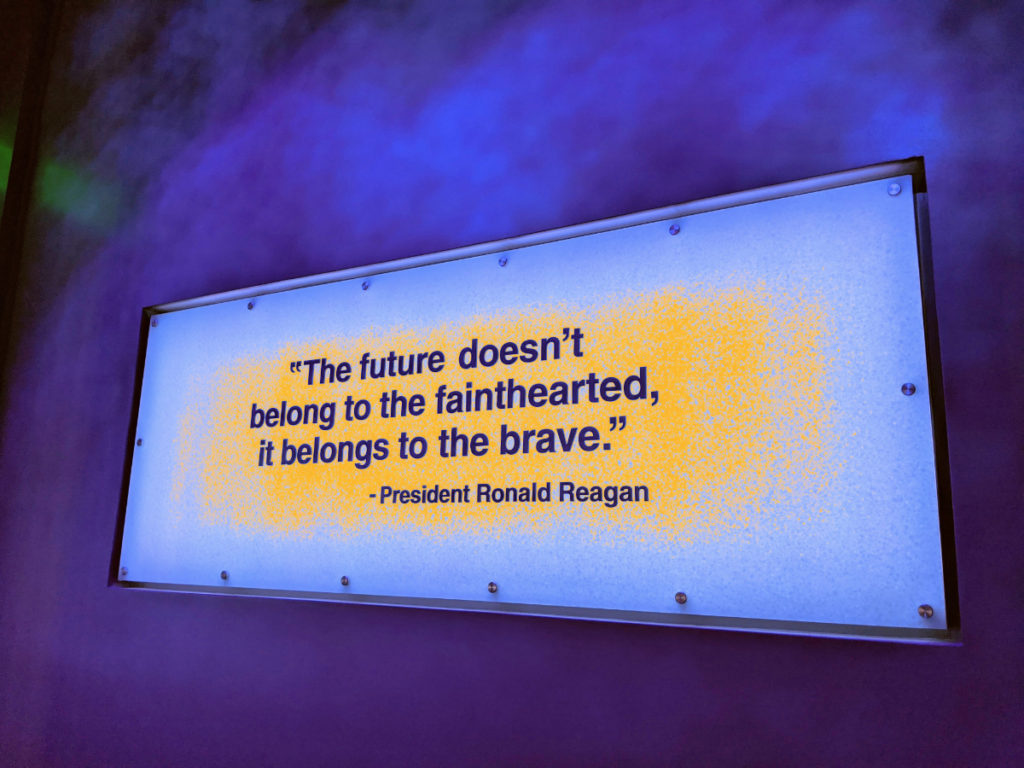
In Conclusion
For my day, getting there early for a launch and doing everything currently available (which means a 45-minutes talk in the theater but no bus tour.) I left for the day at about 3:00 and continued my way up the coast on A1A.
You might want more time than that if you are deeply interested in the subject matter or want to do some of the extras. For most of us, it’s easy to do in one day, especially as a day trip from the Disney/Universal area. (Or as a stop on the A1A.)
EDIT: Adding in the Apollo/Saturn V Center, I’d say the Kennedy Space Center is definitely a full day, if not slightly more than a day for those who want to see everything. Even so, hours tend to be 9-5, so you can’t get caught there too late.
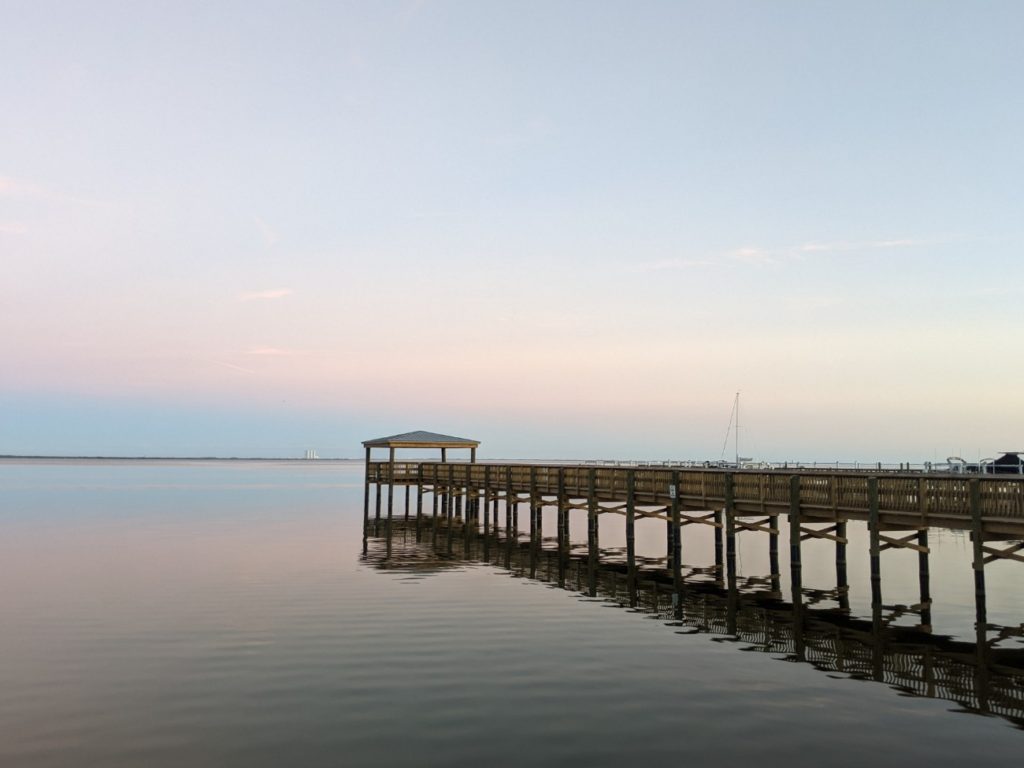
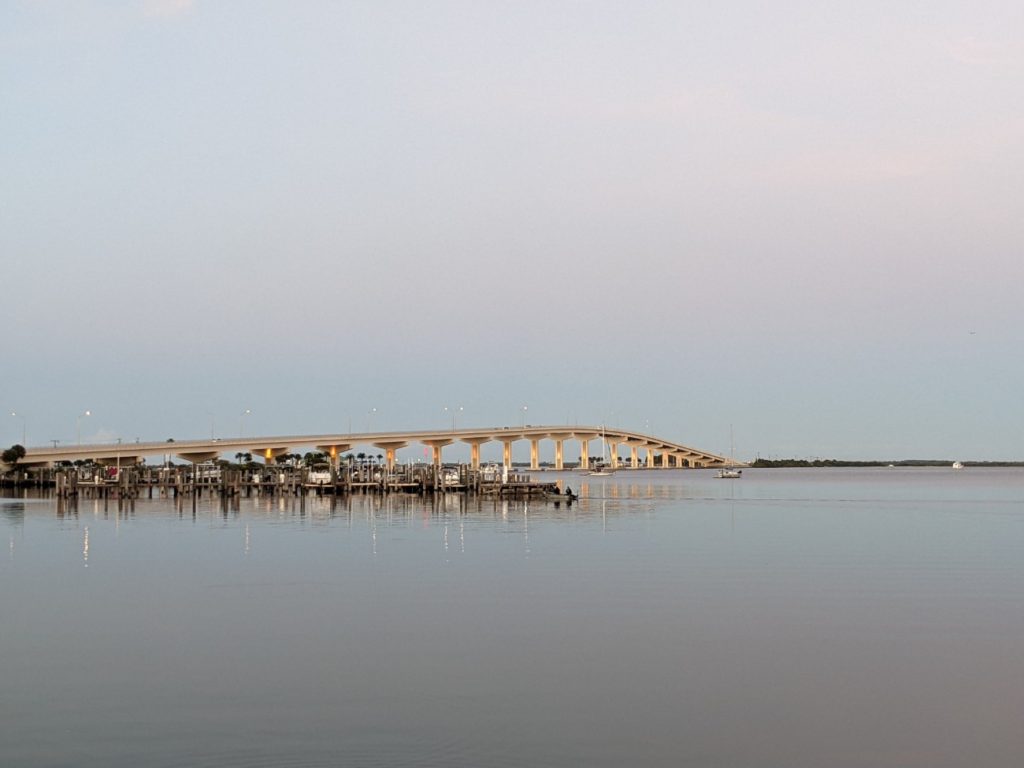
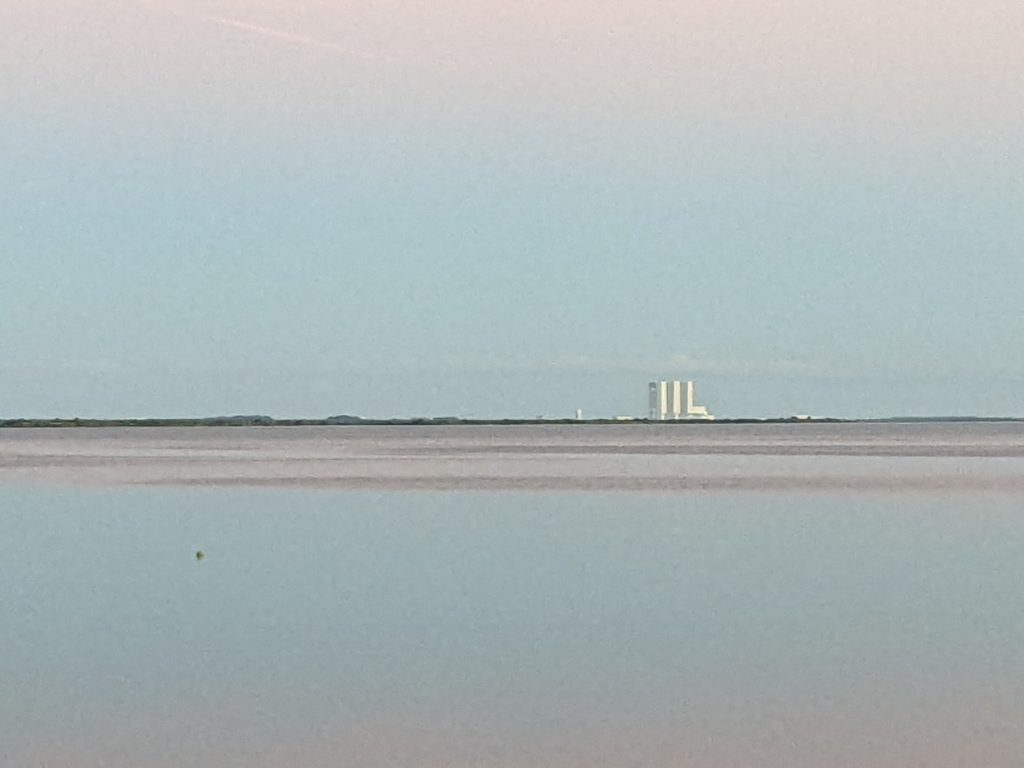
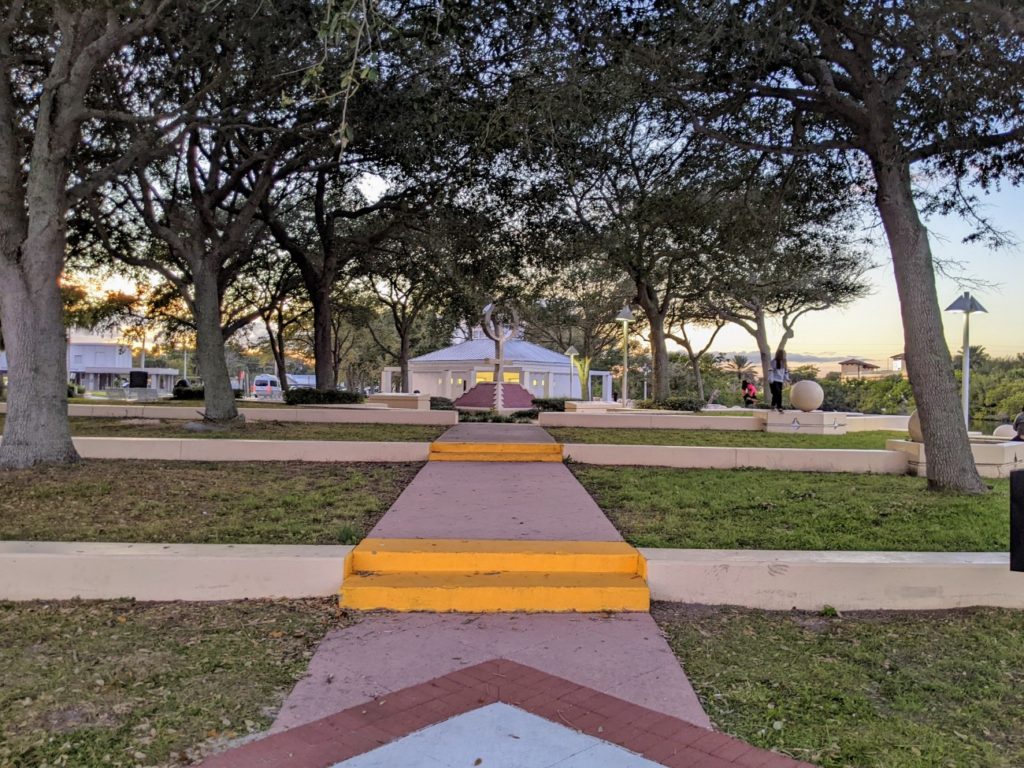
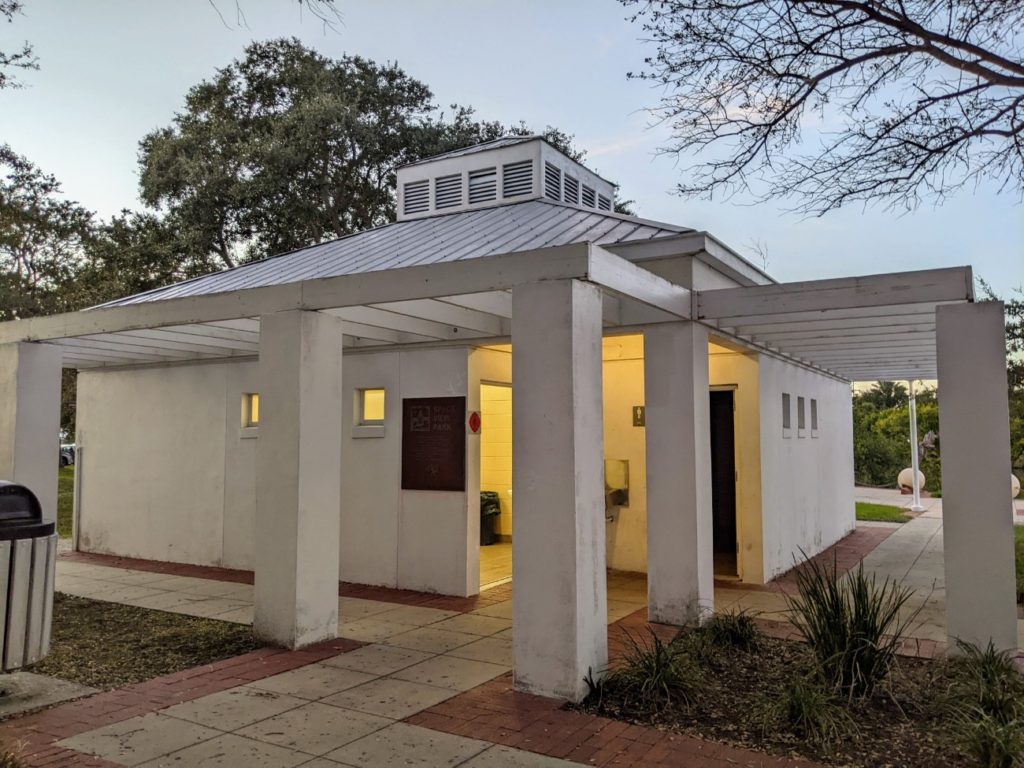
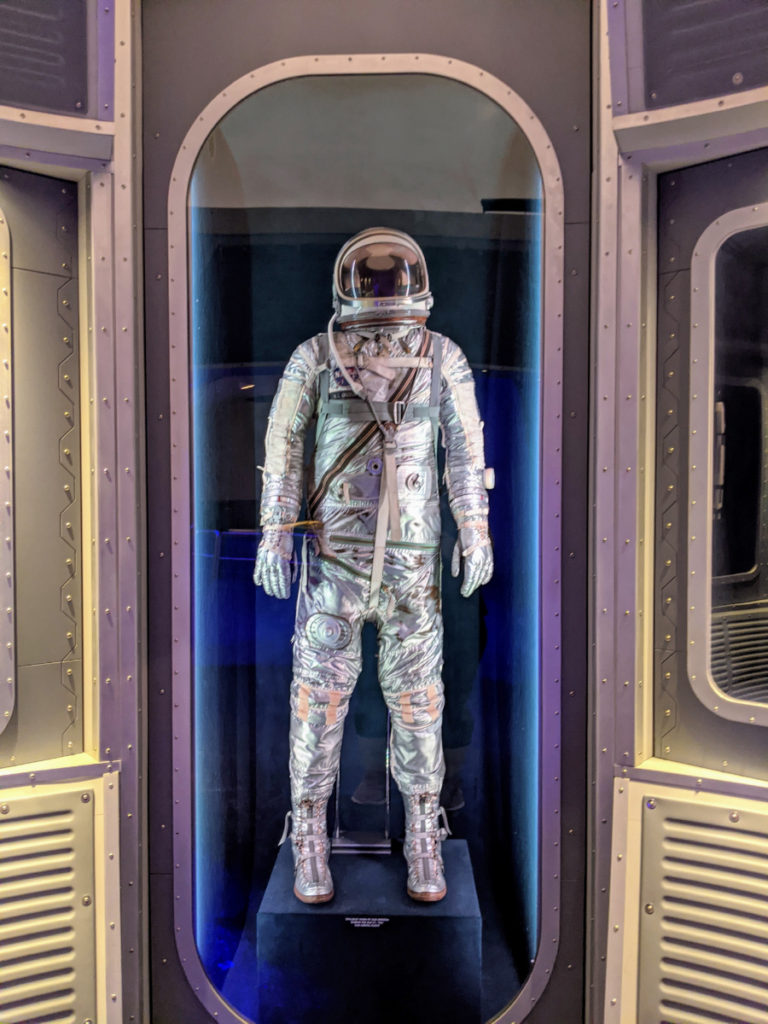
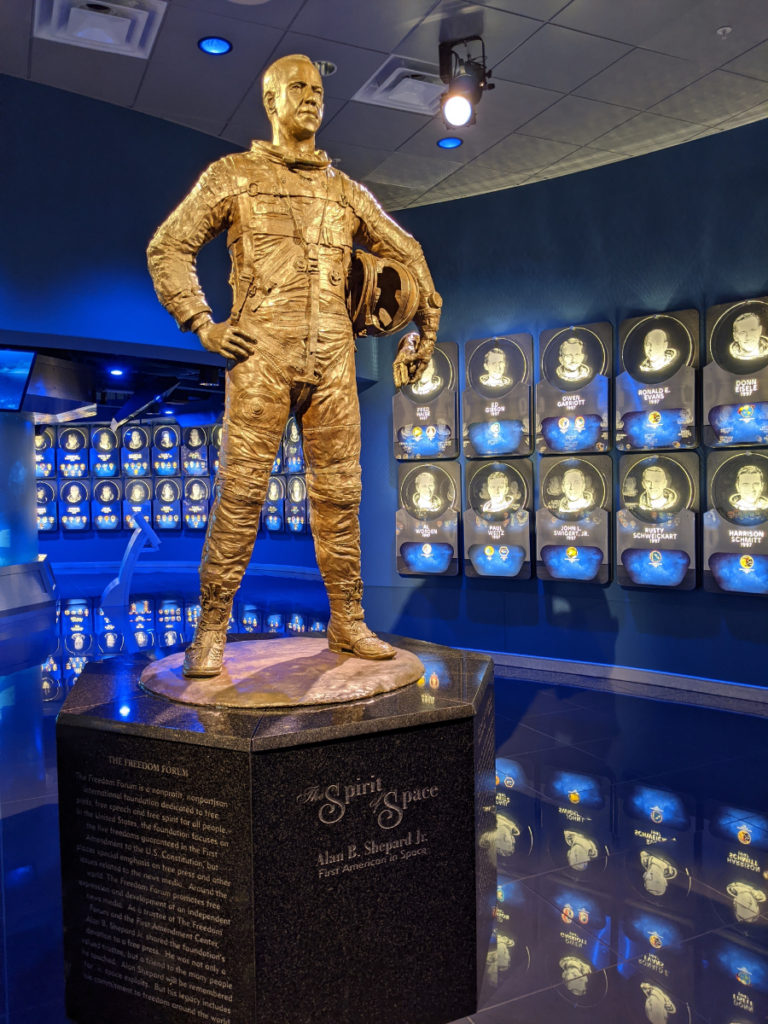
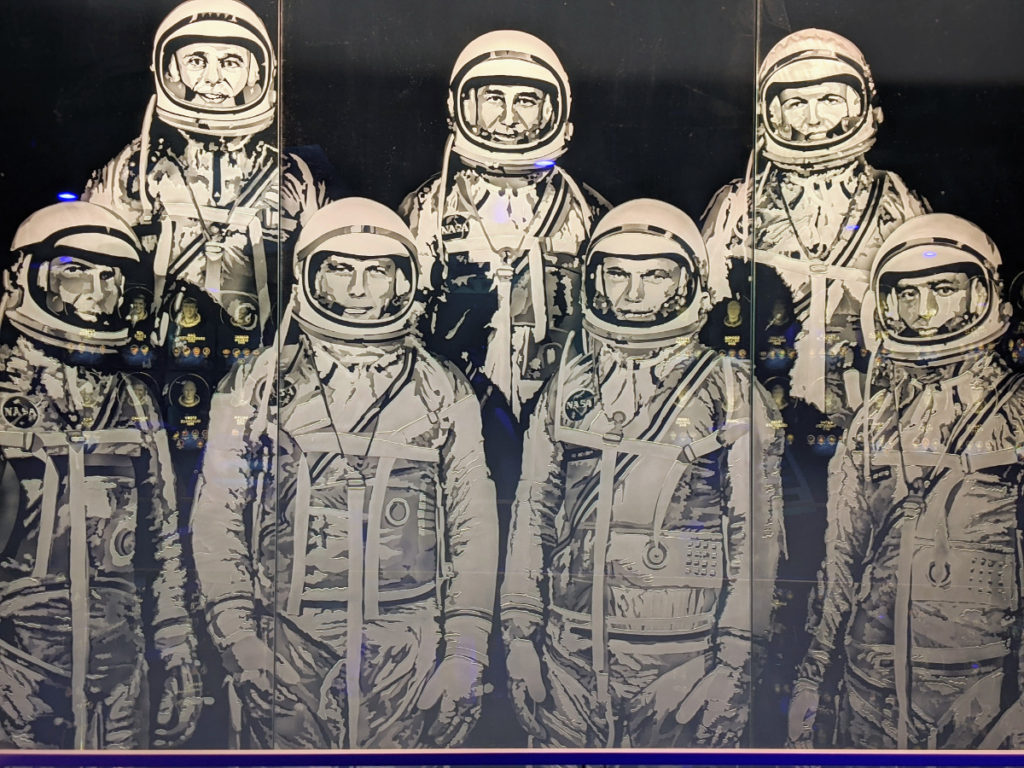
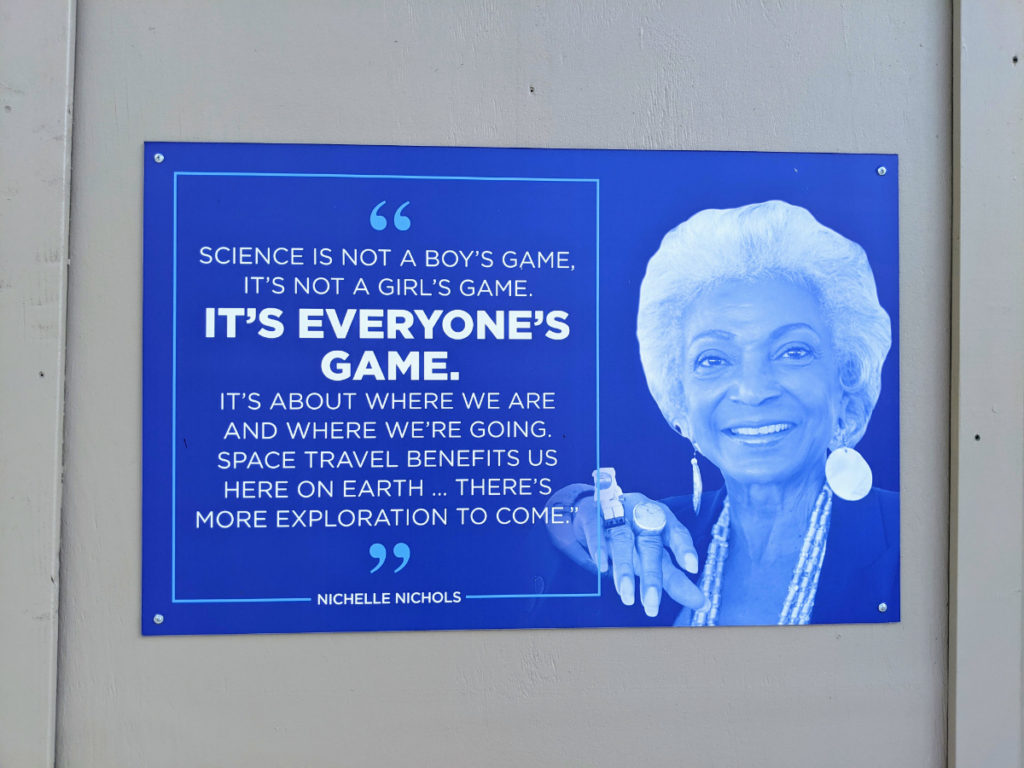
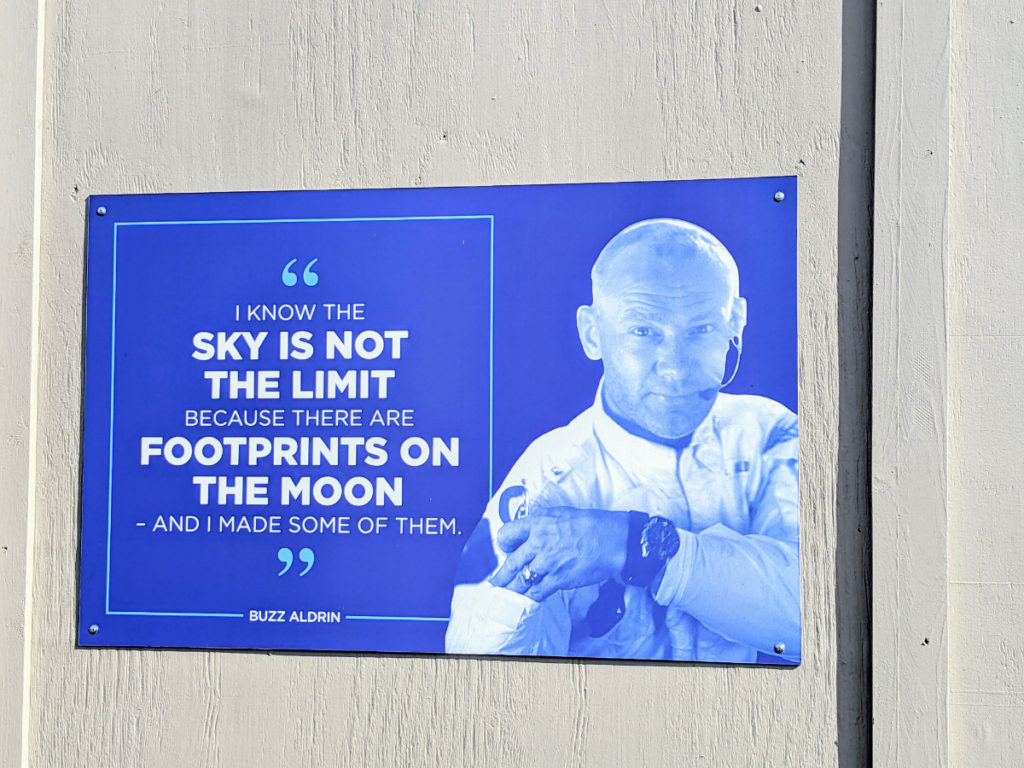
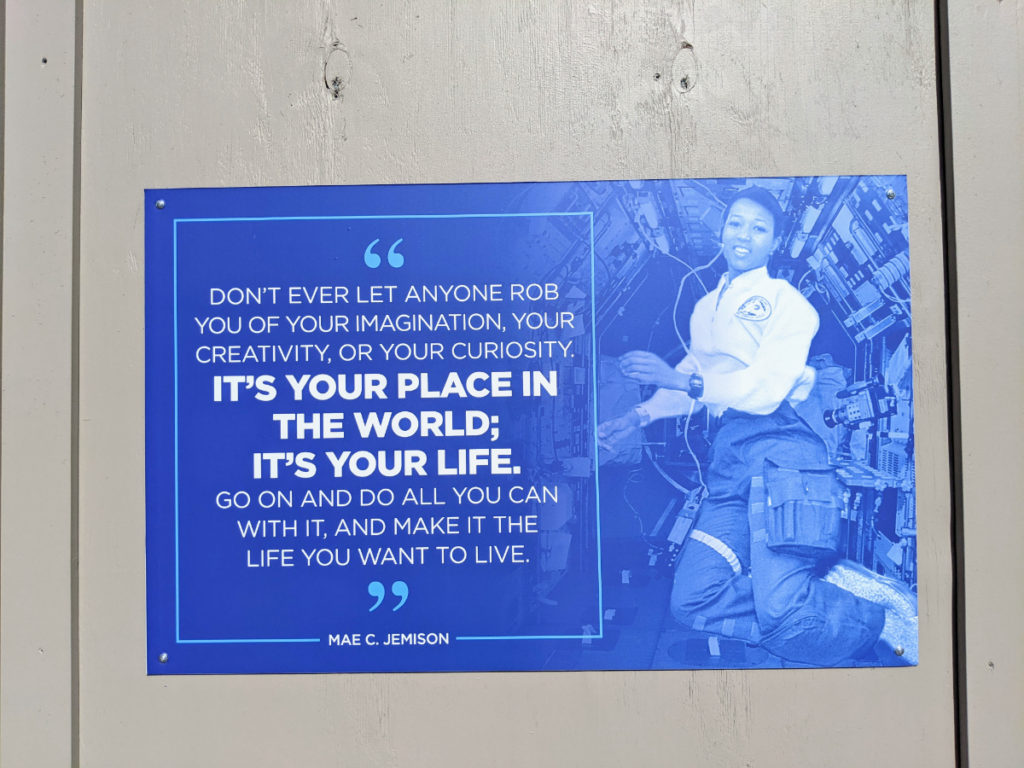
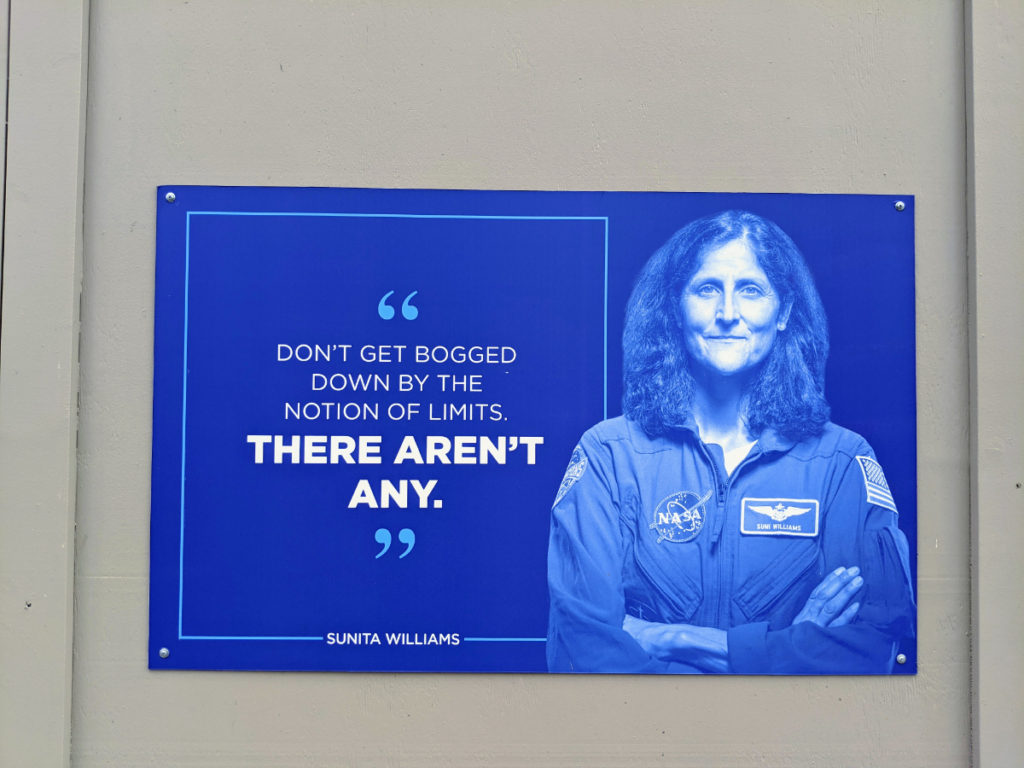
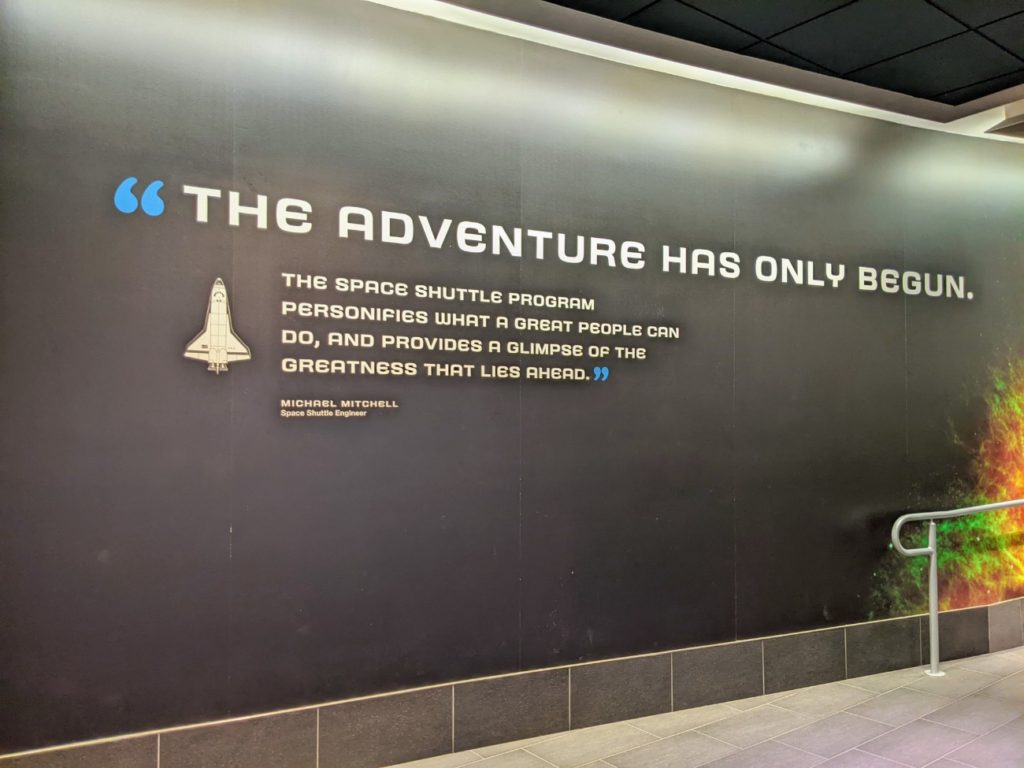
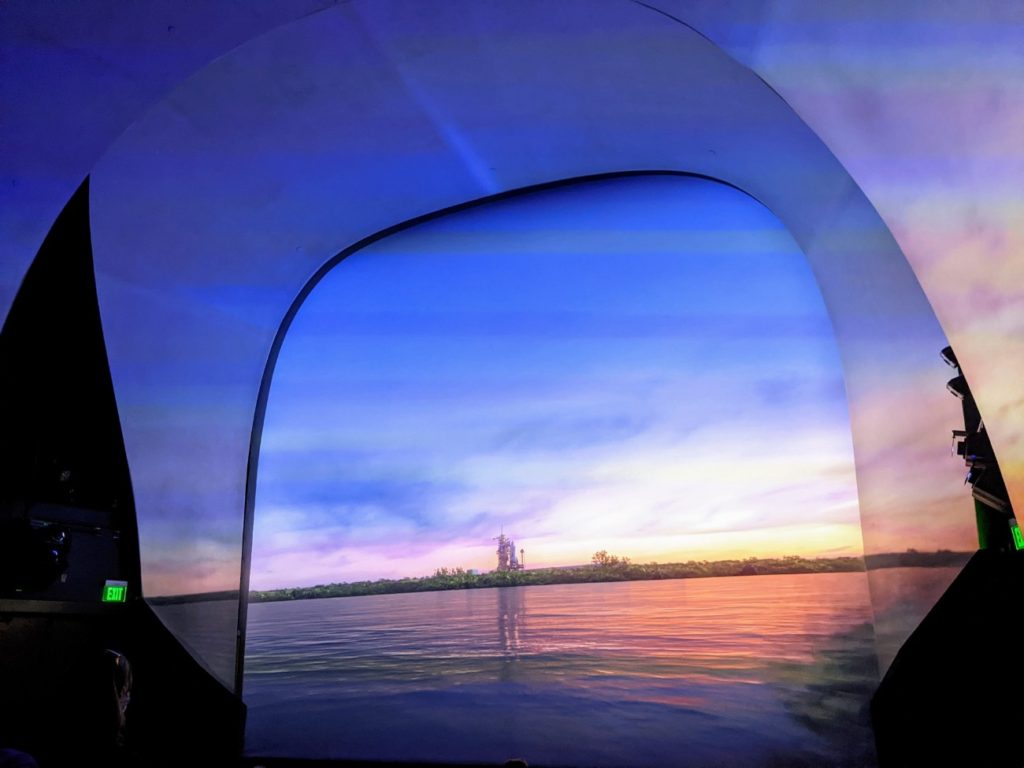
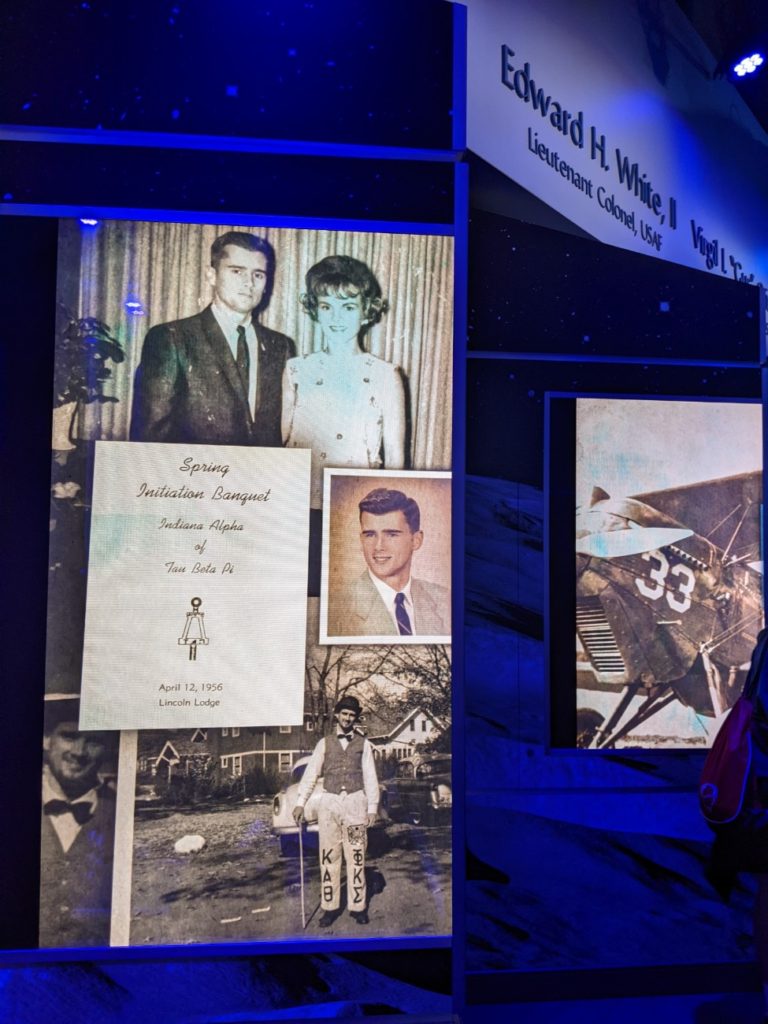
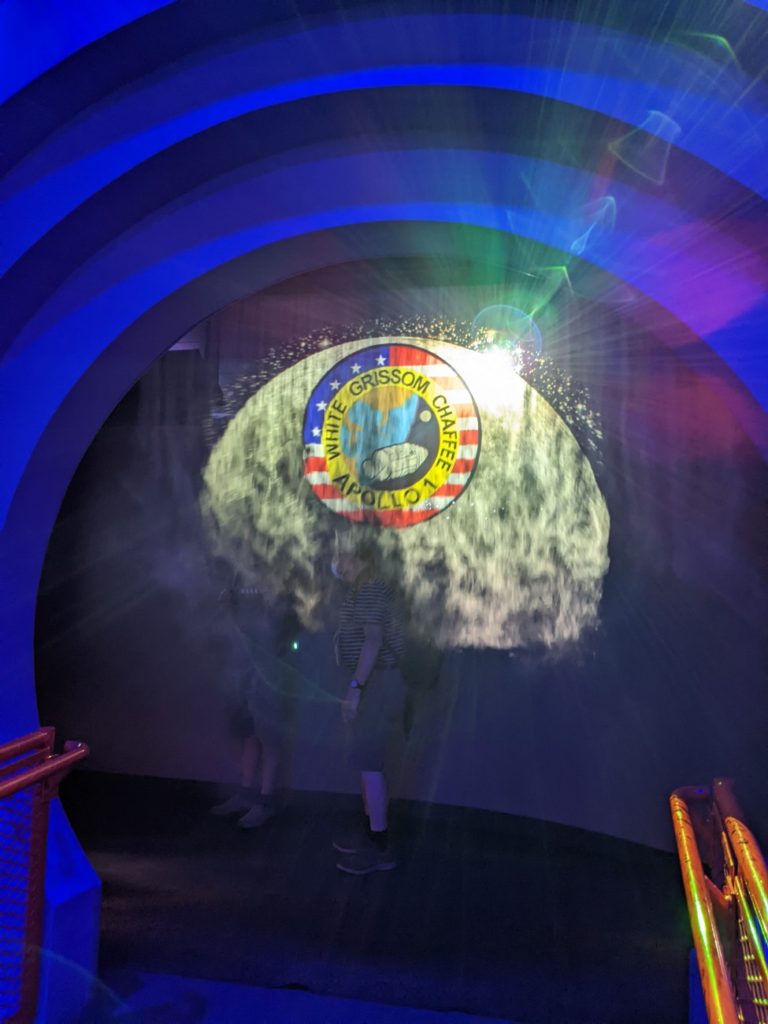
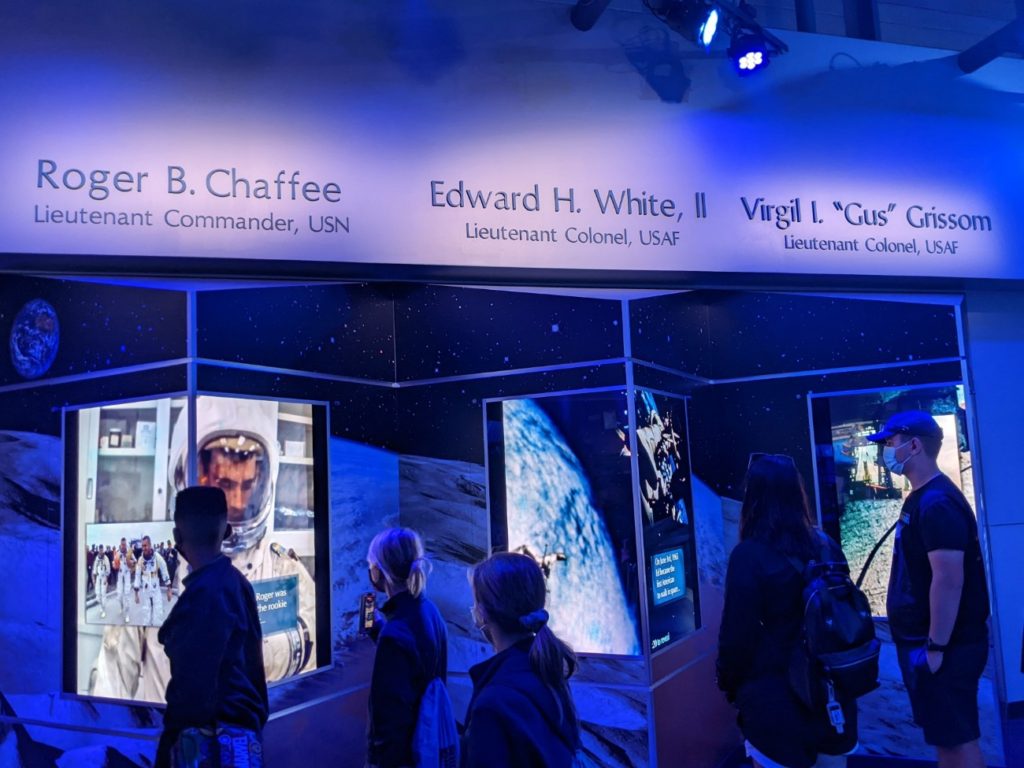
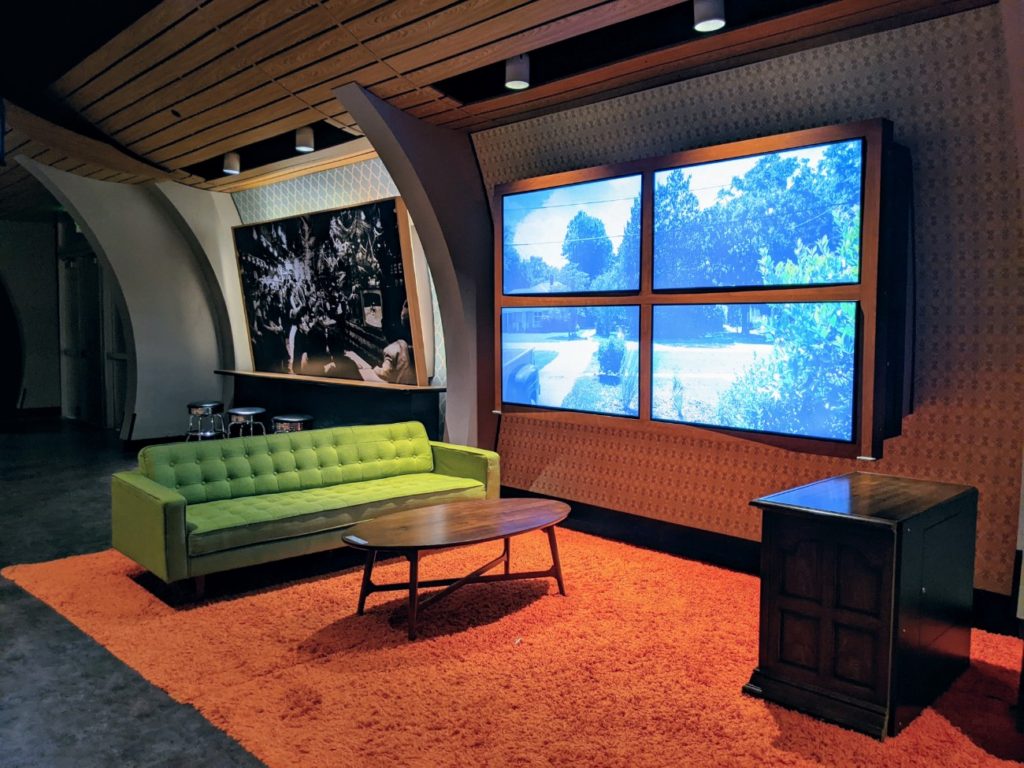
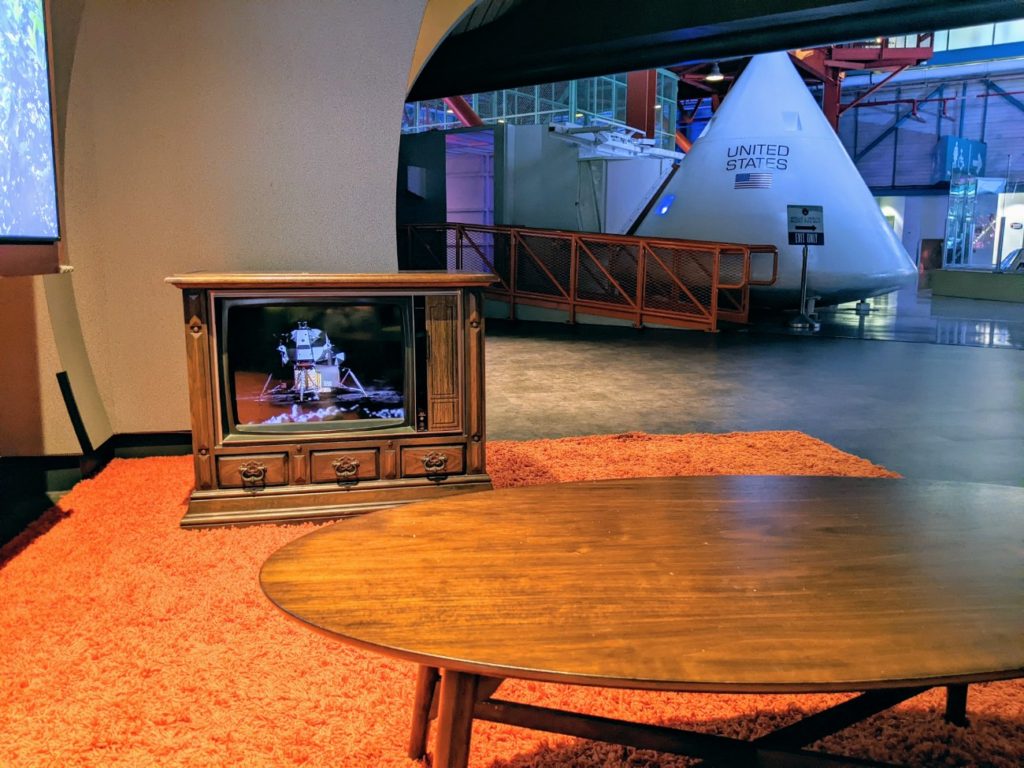
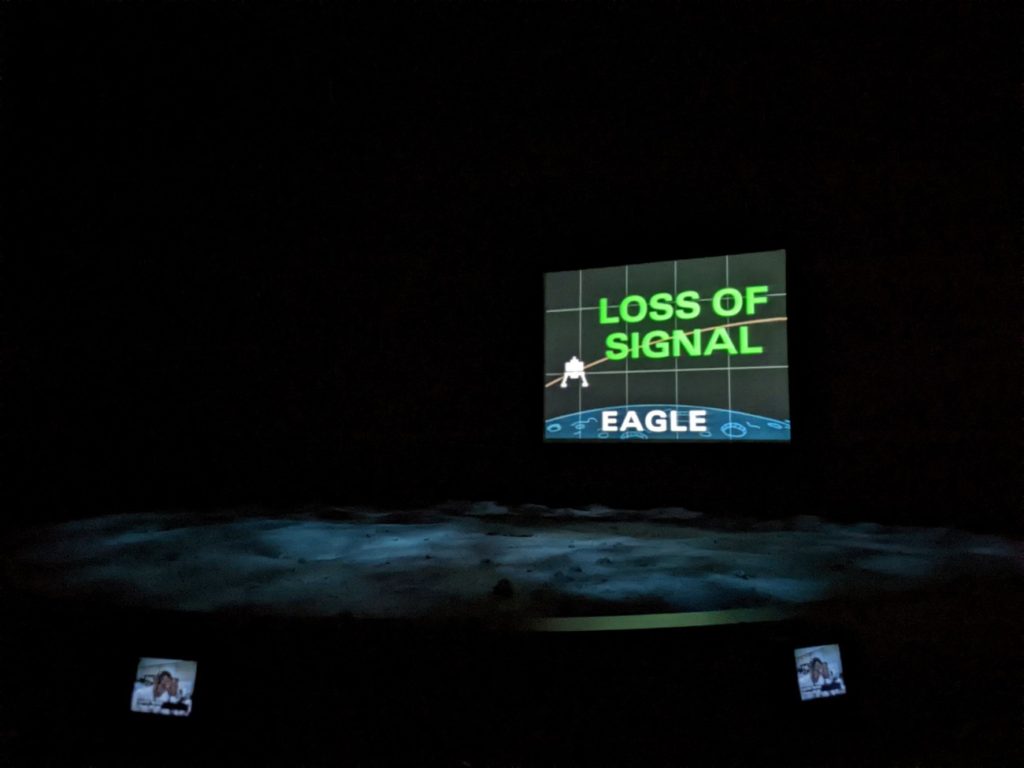
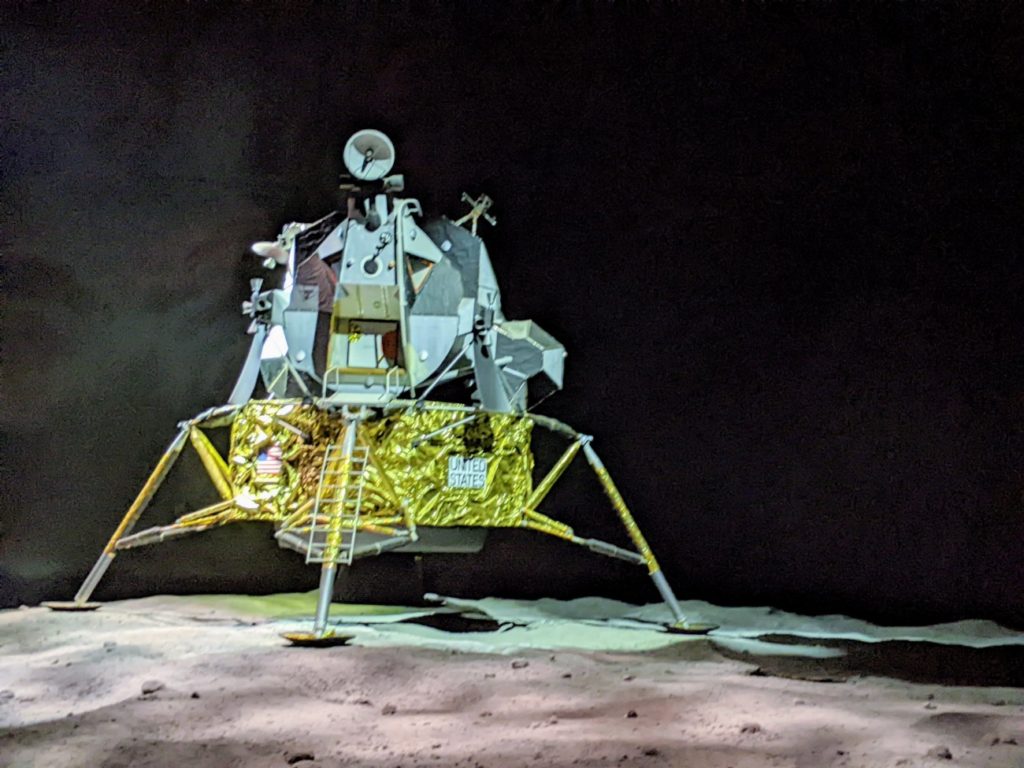
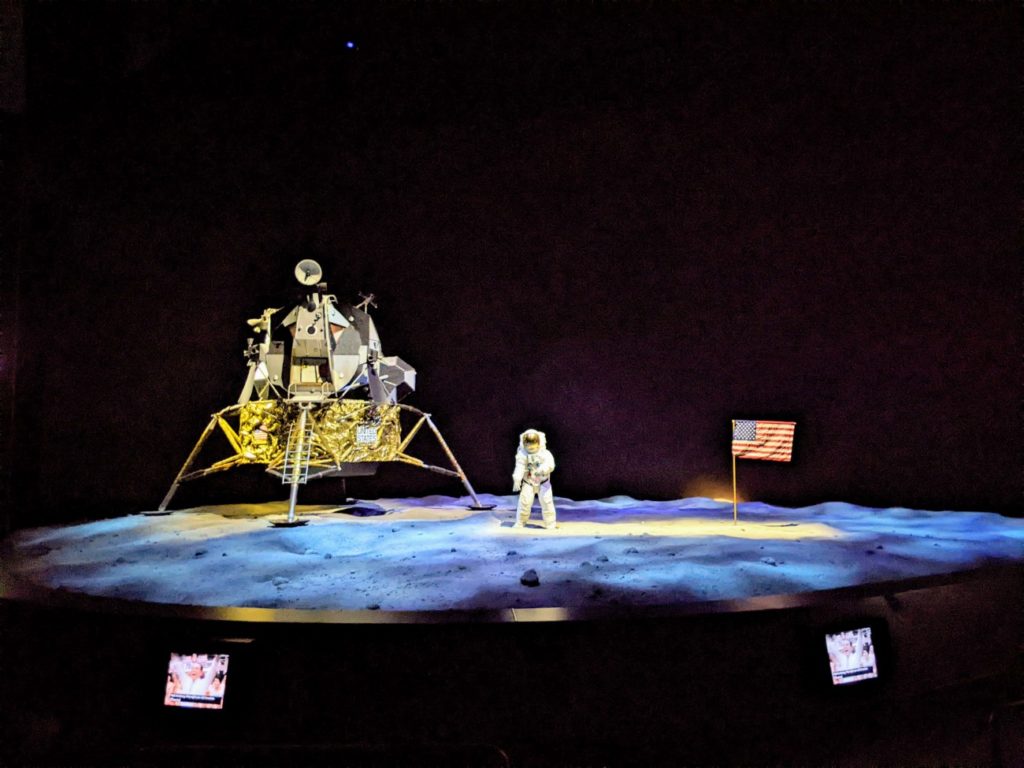
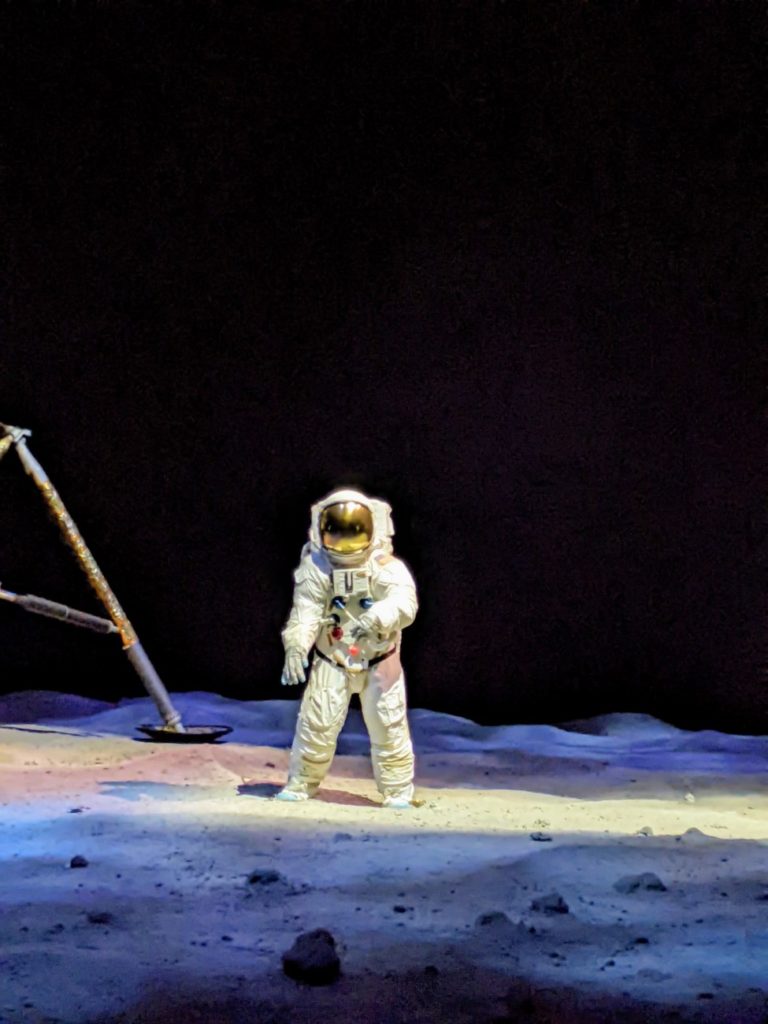
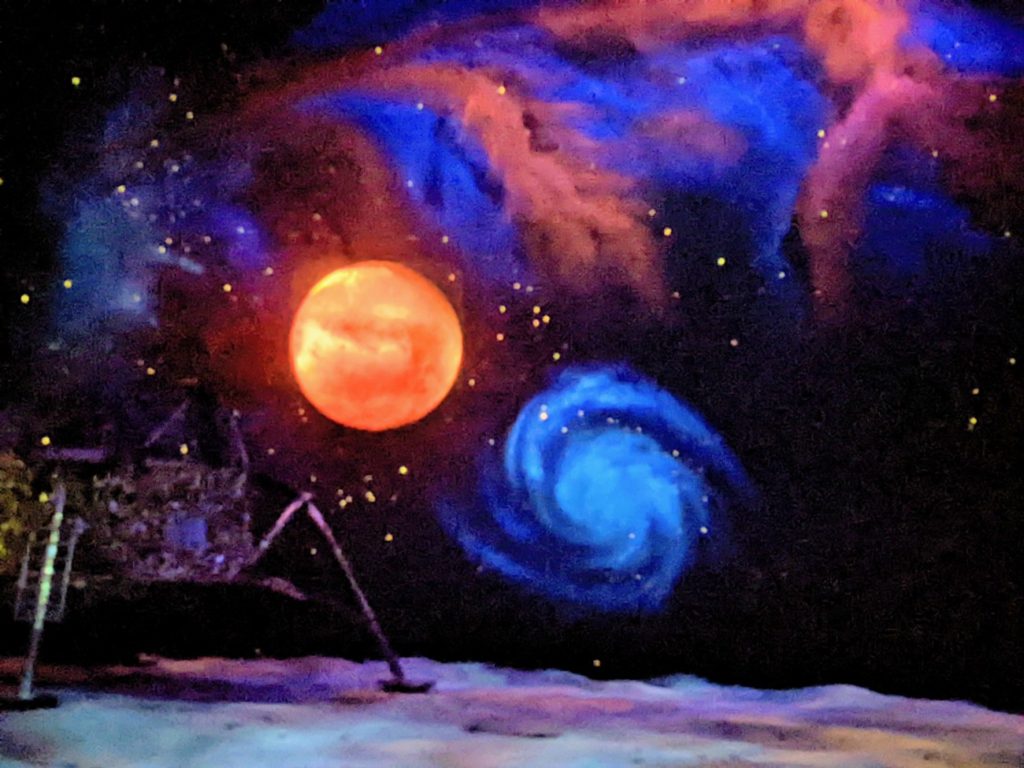
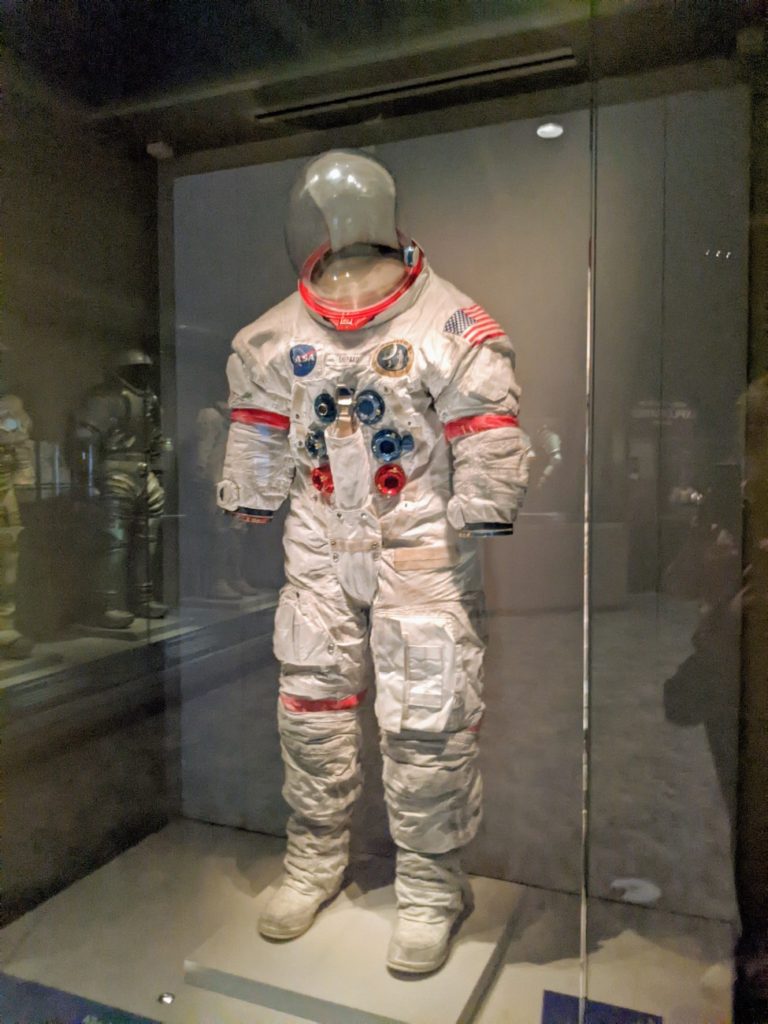
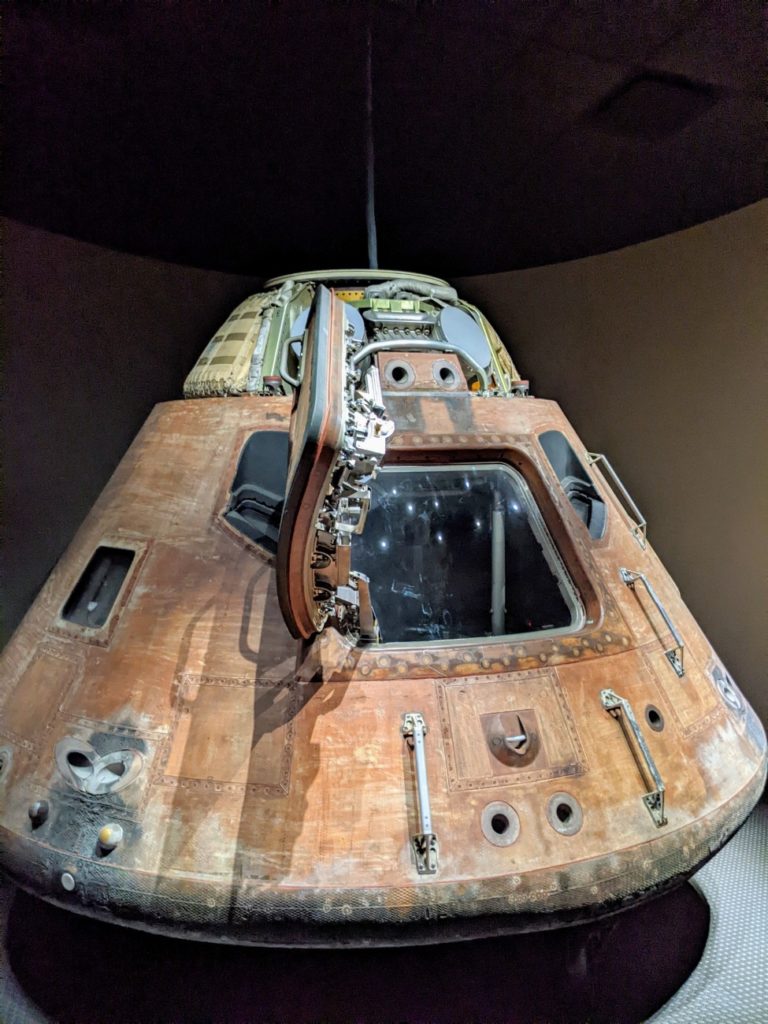
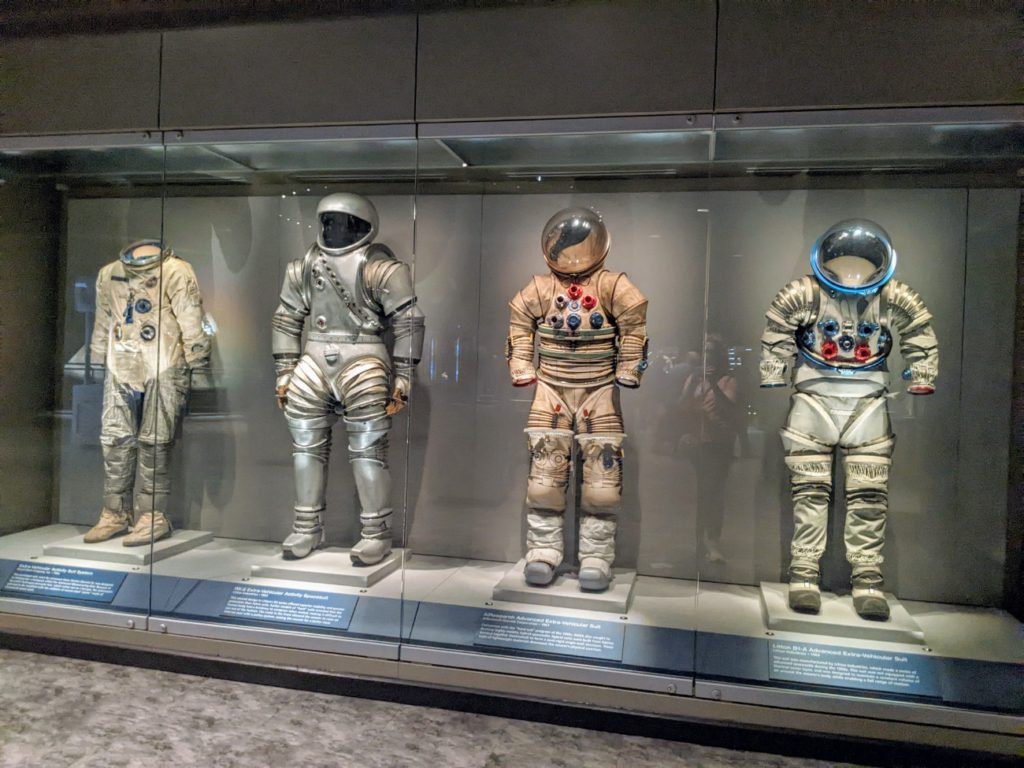
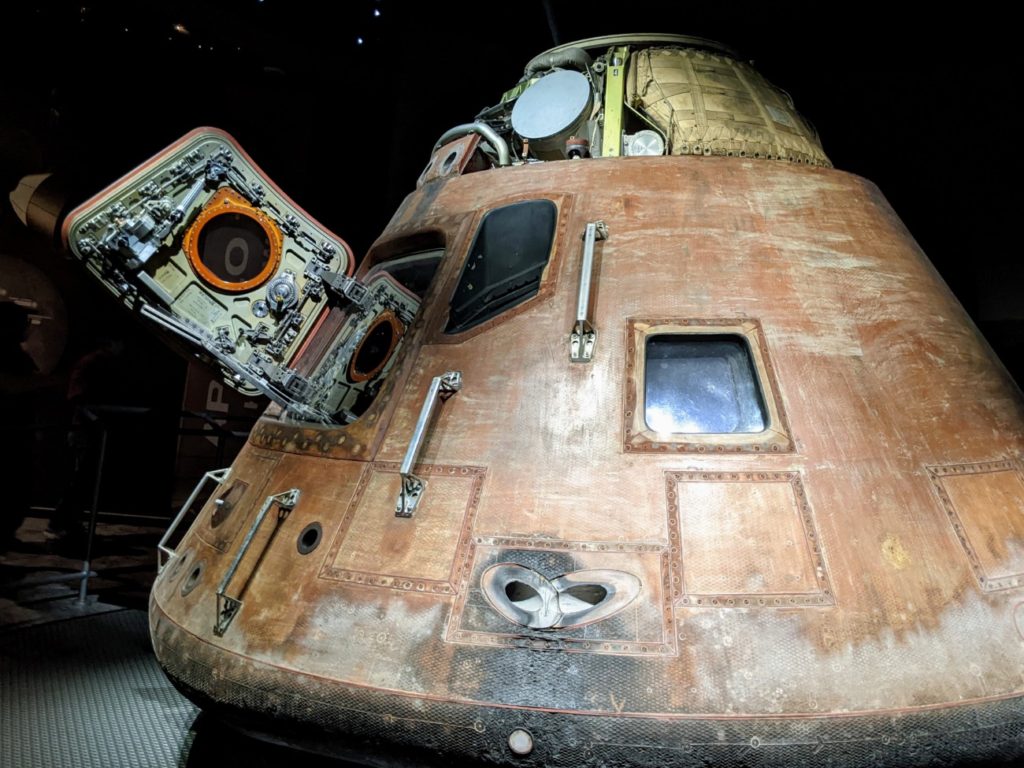
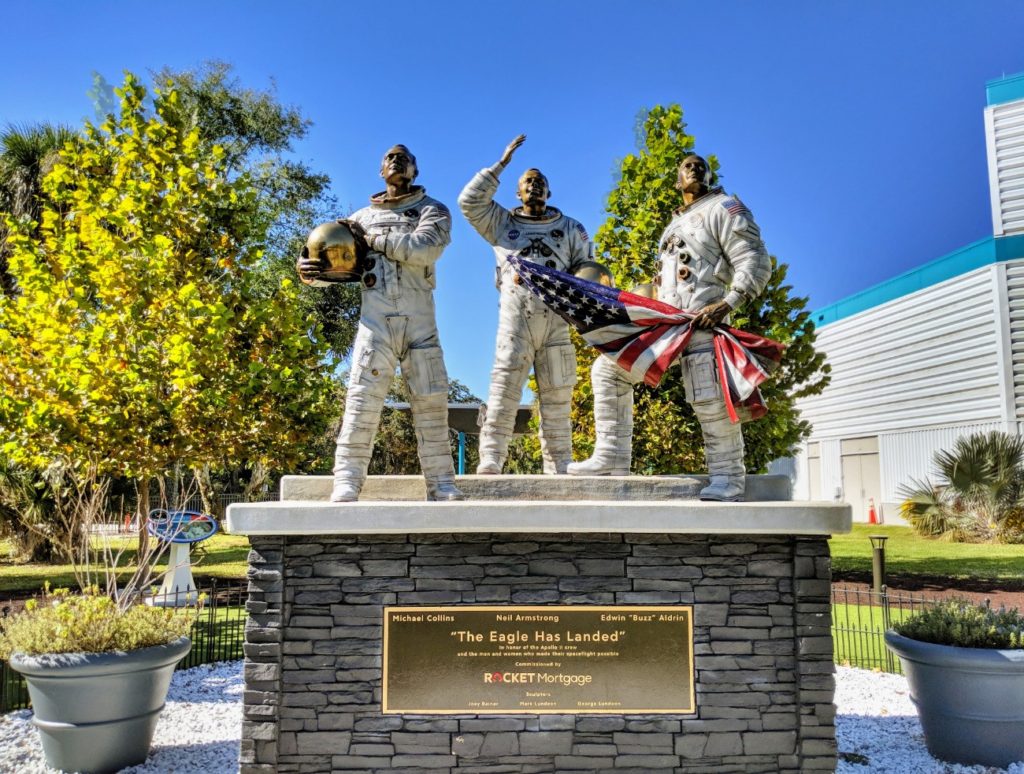
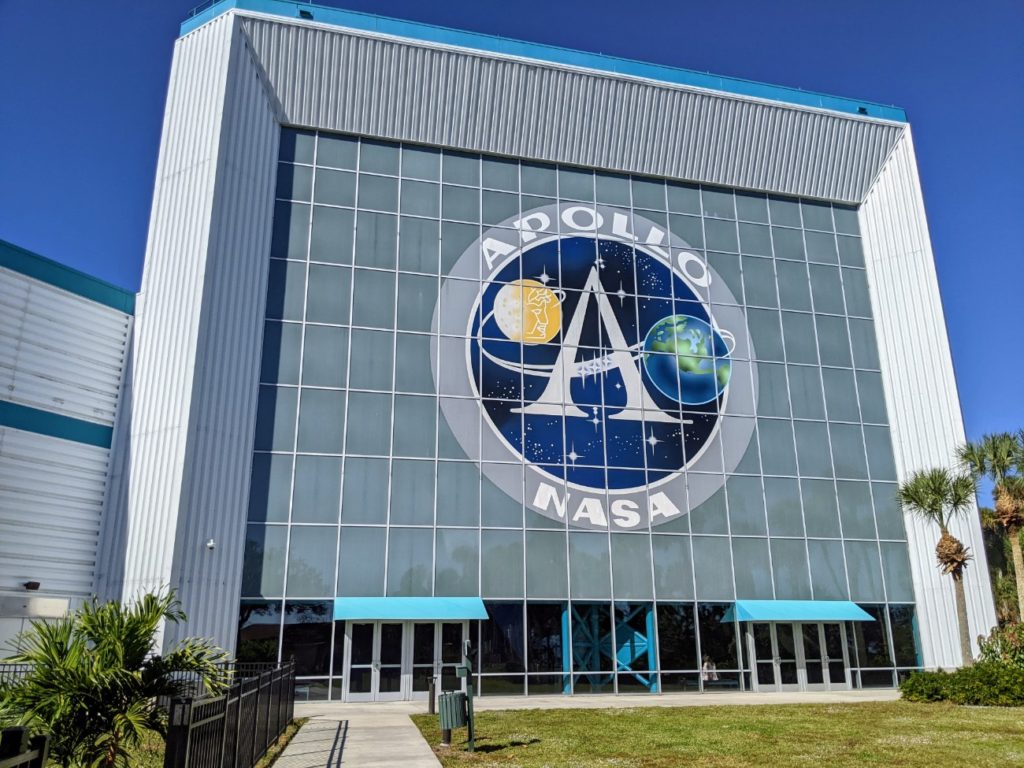
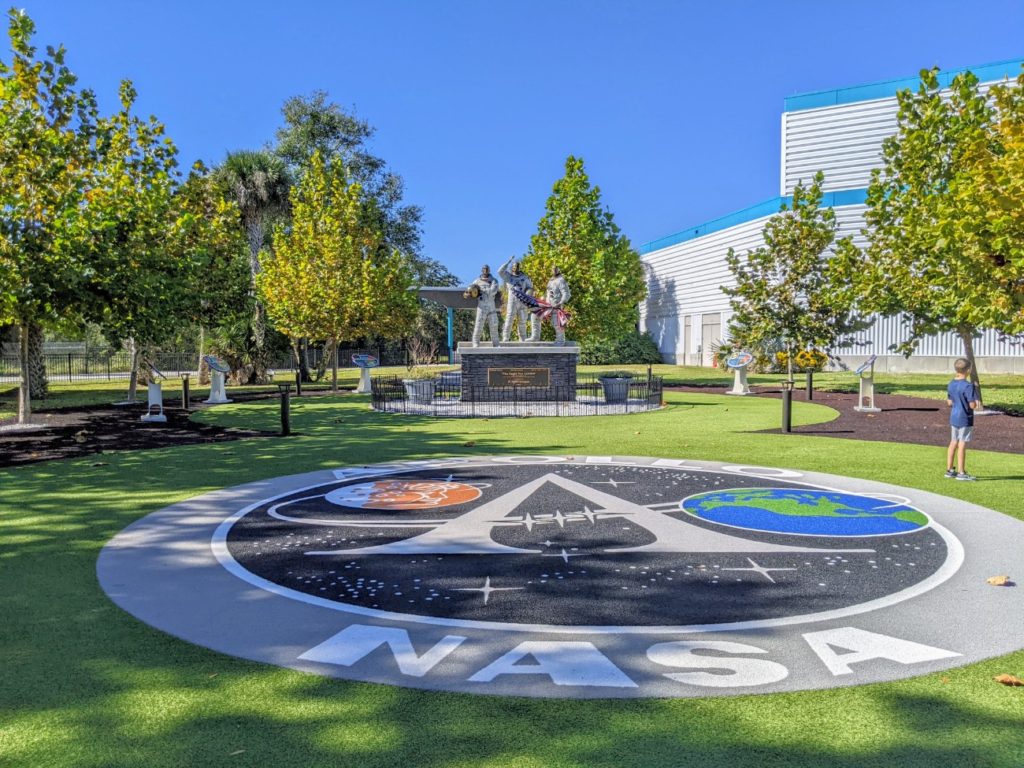
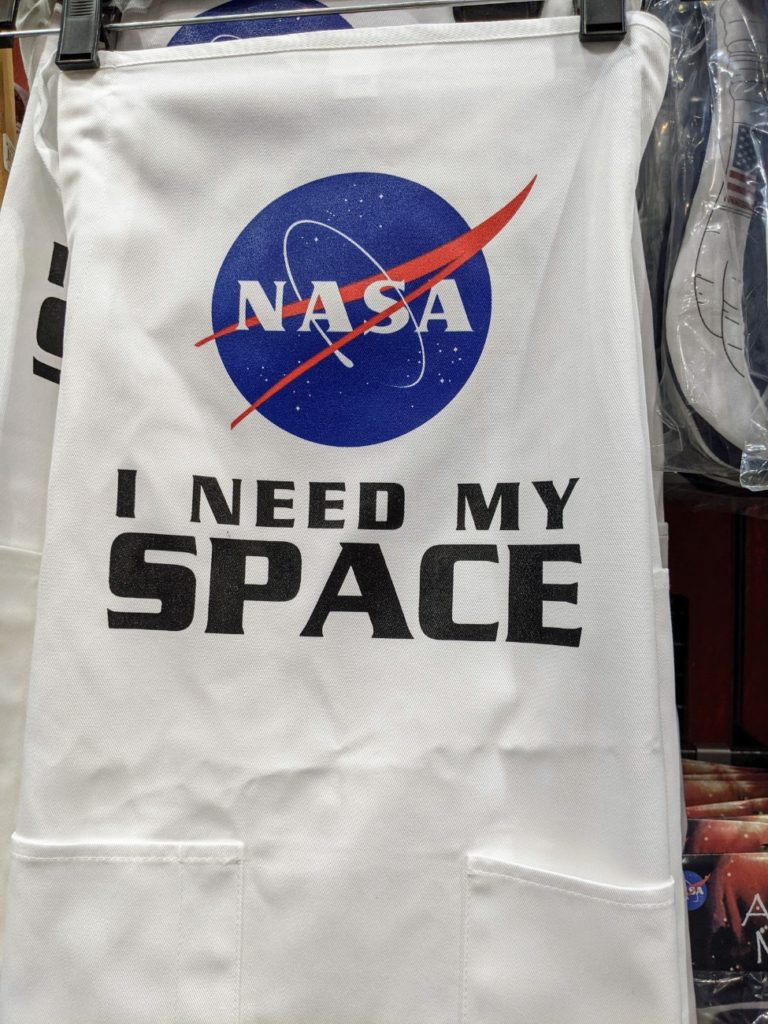
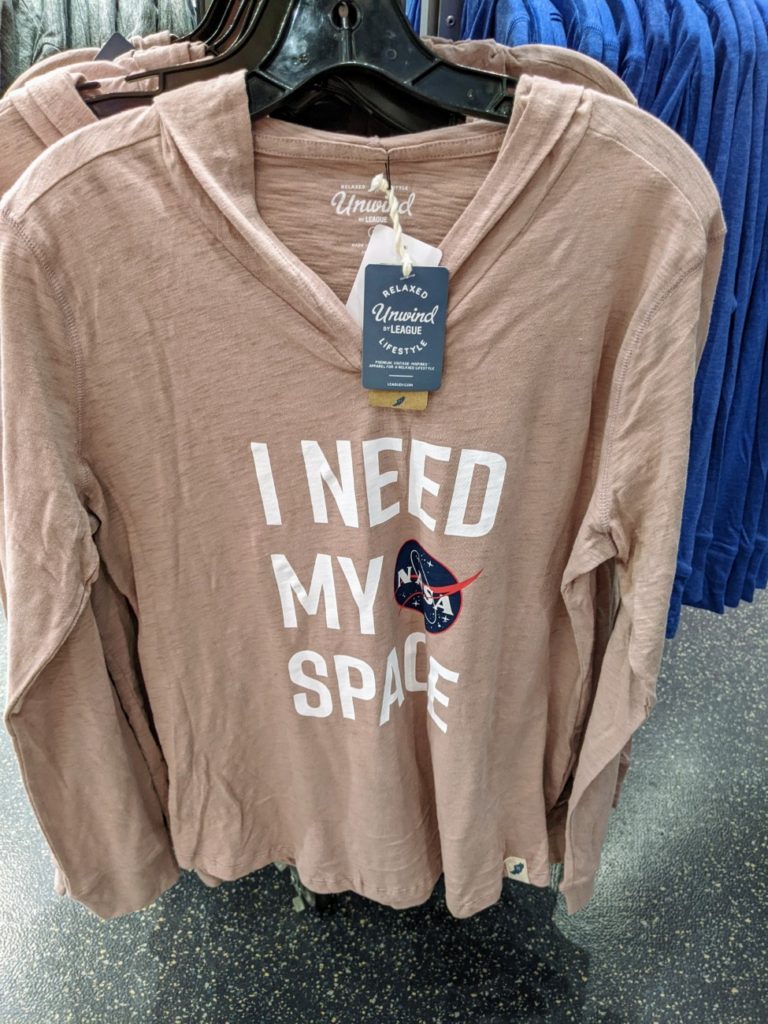
Be First to Comment